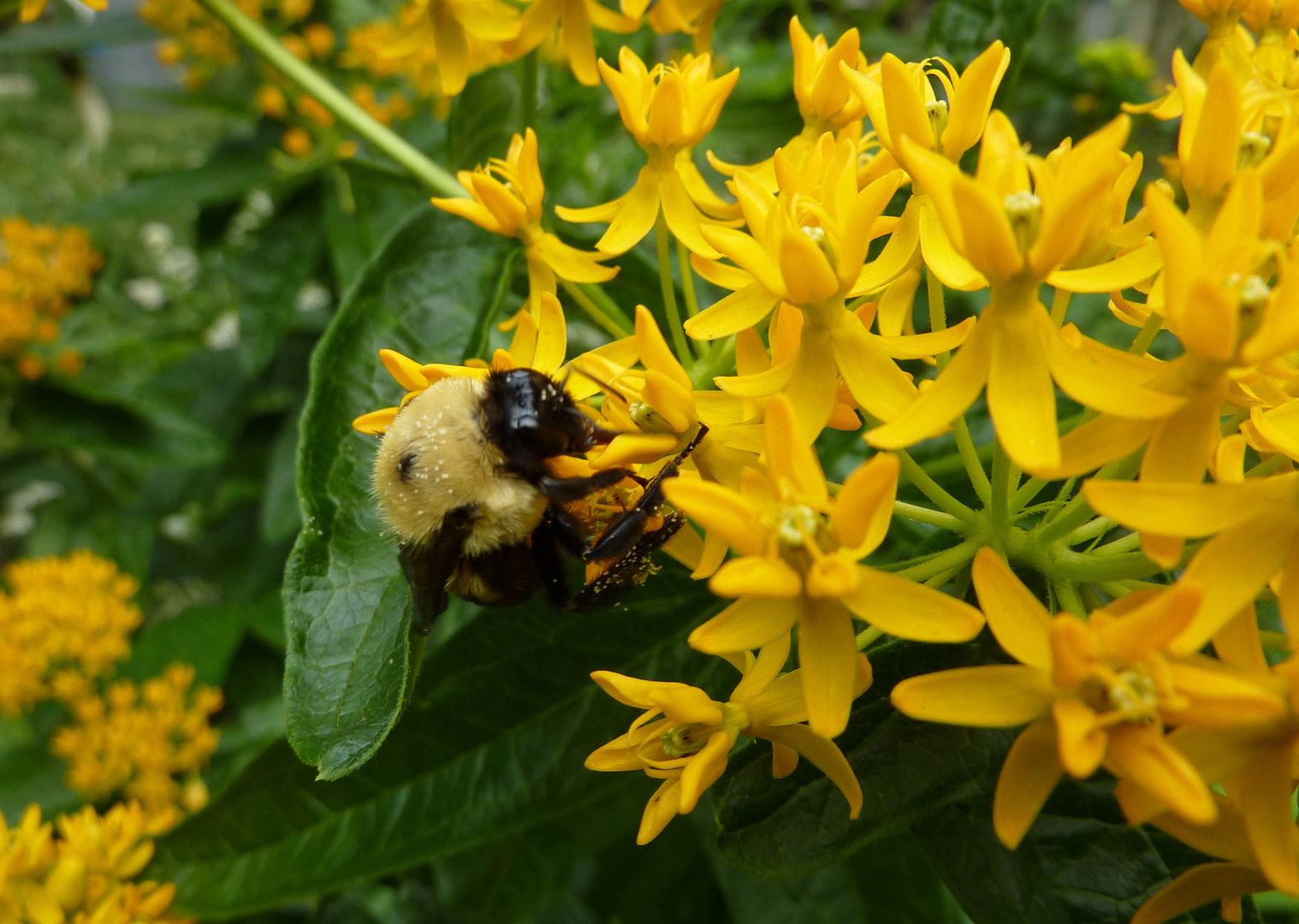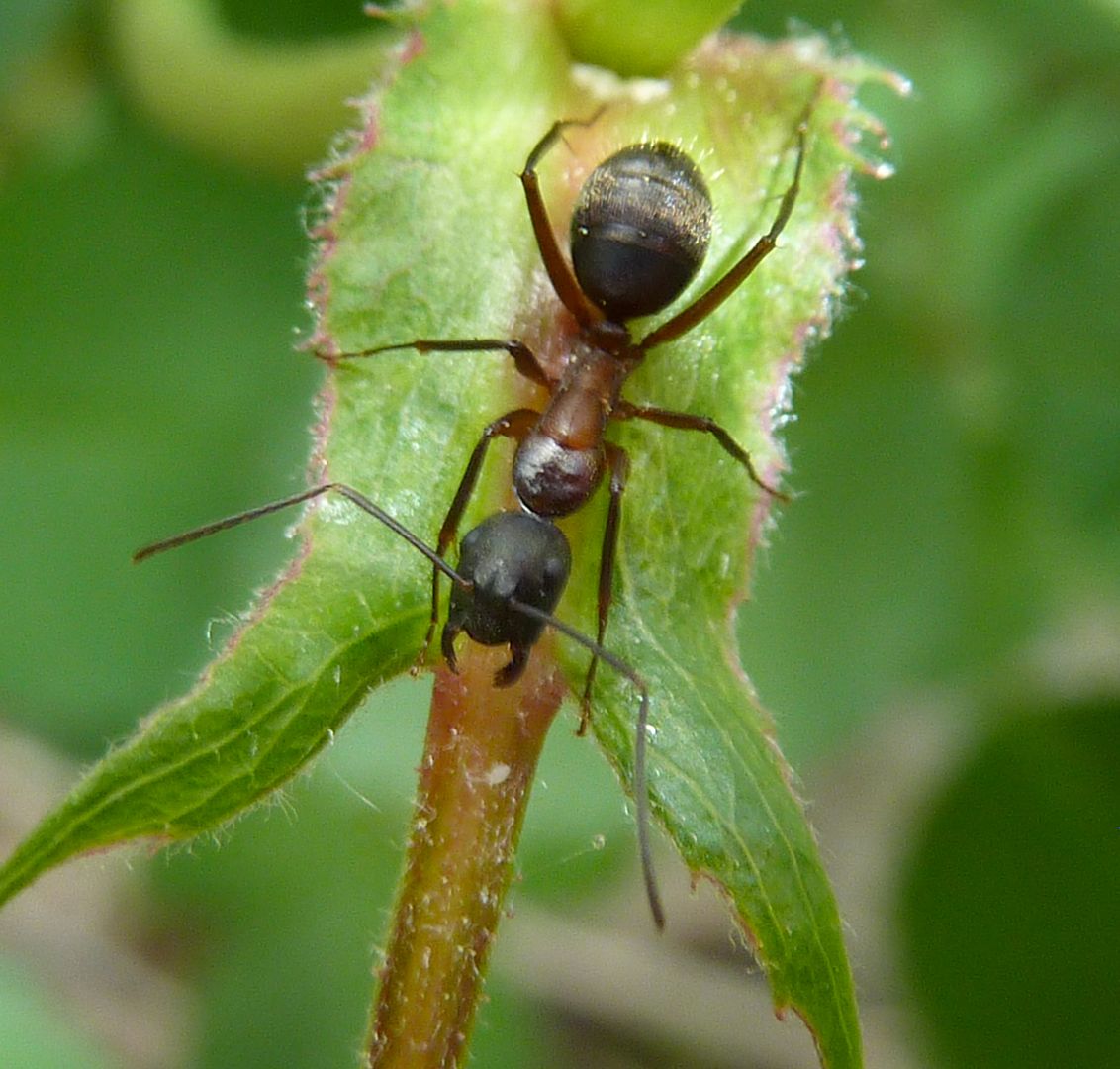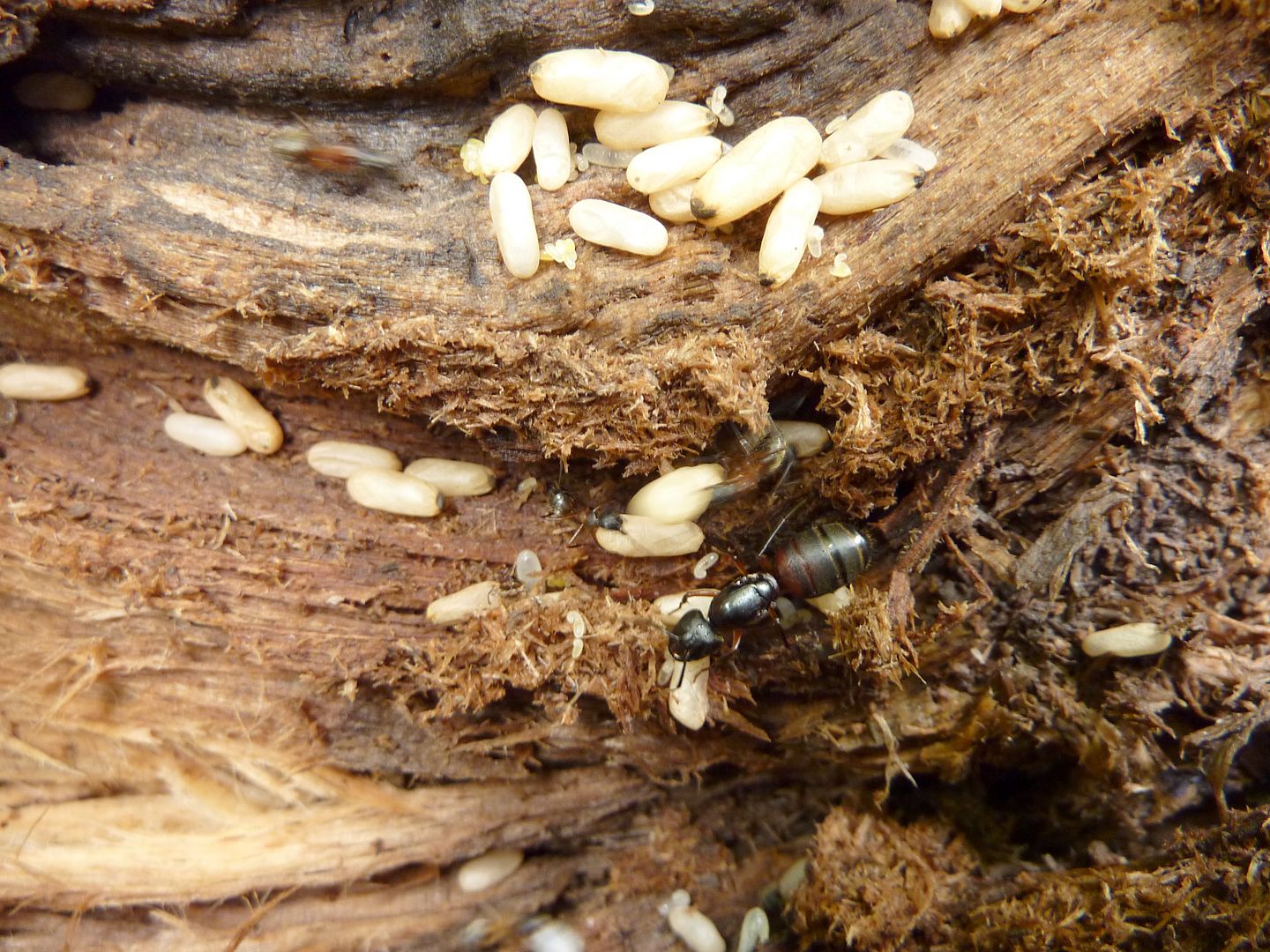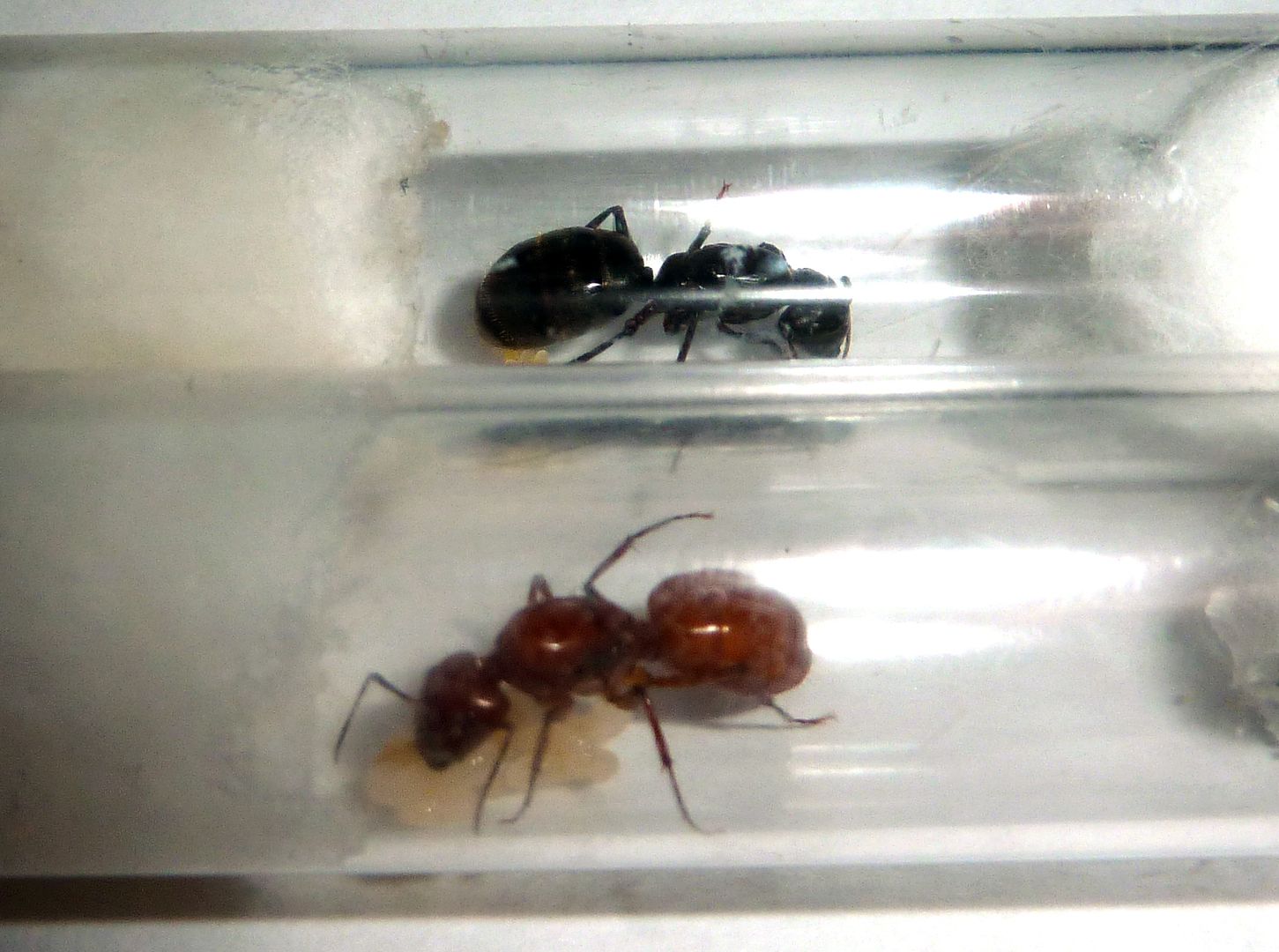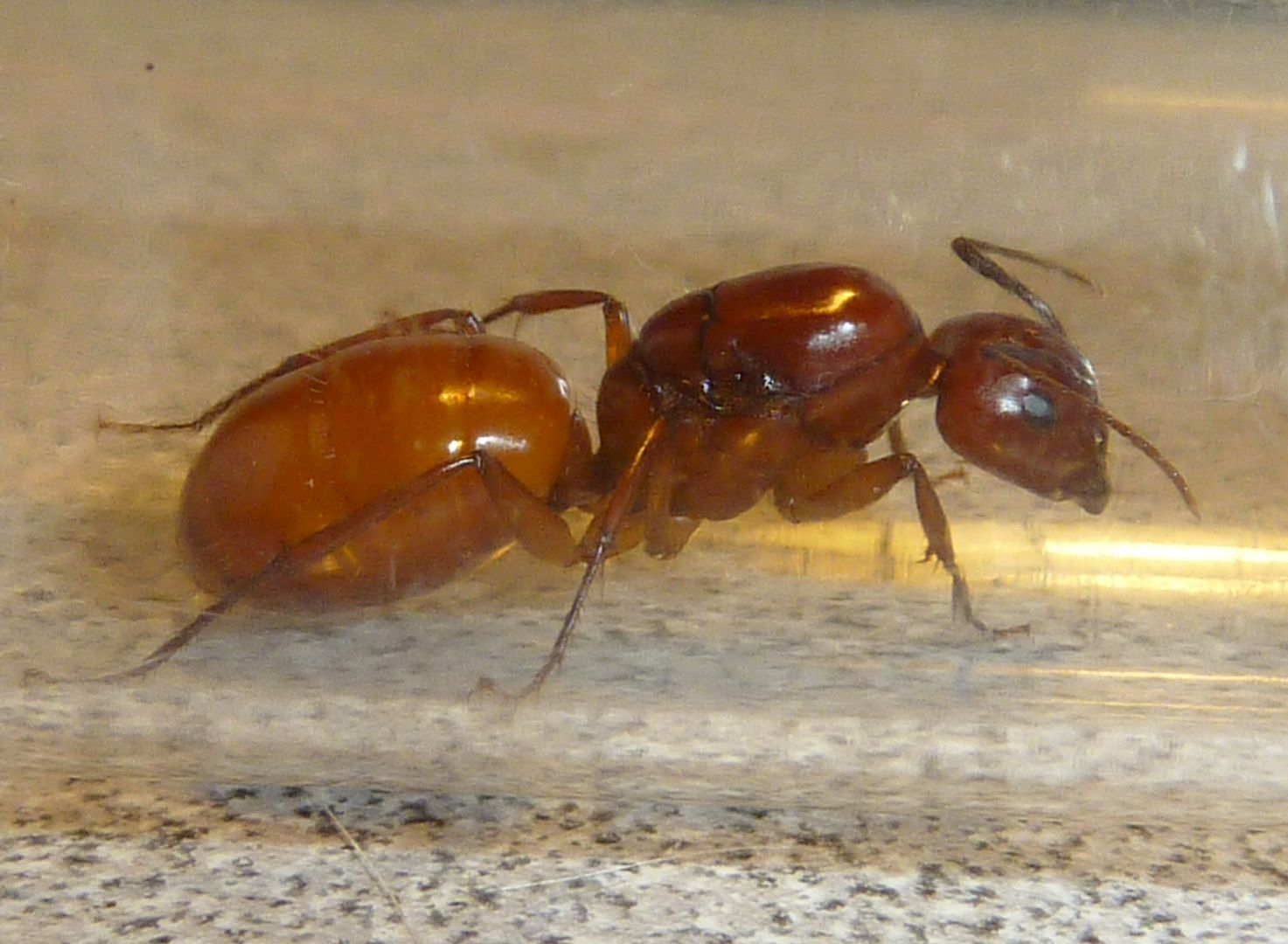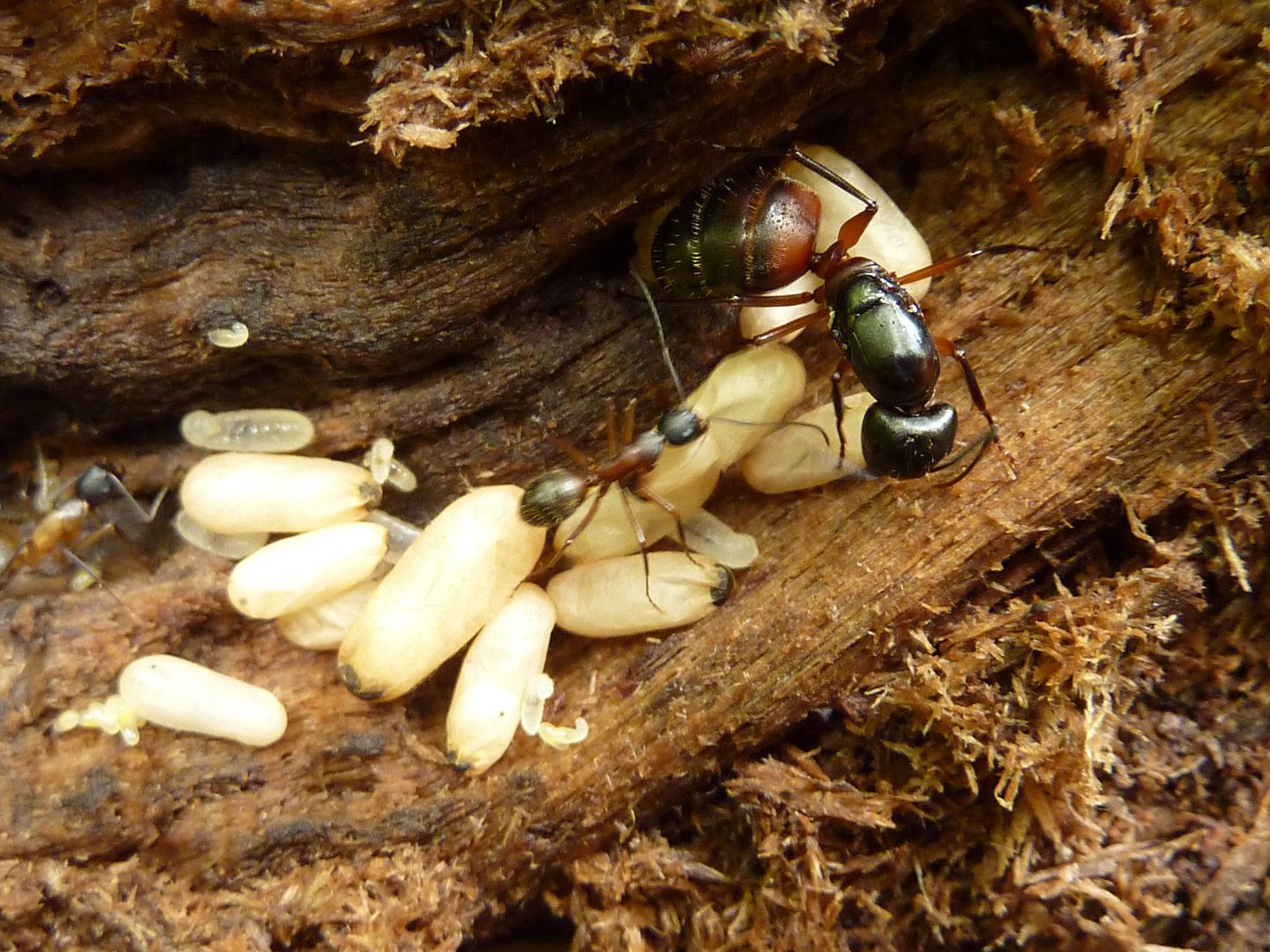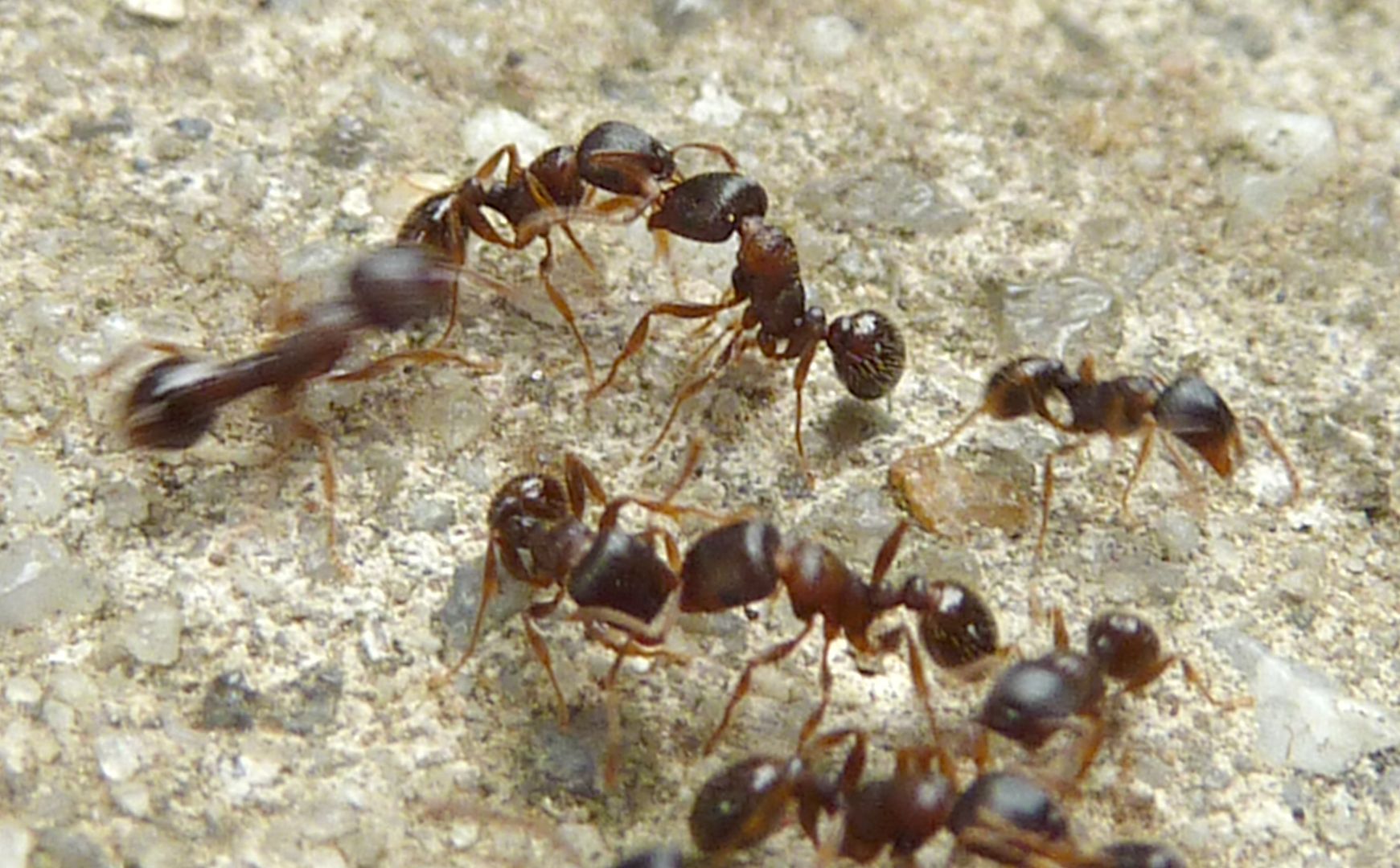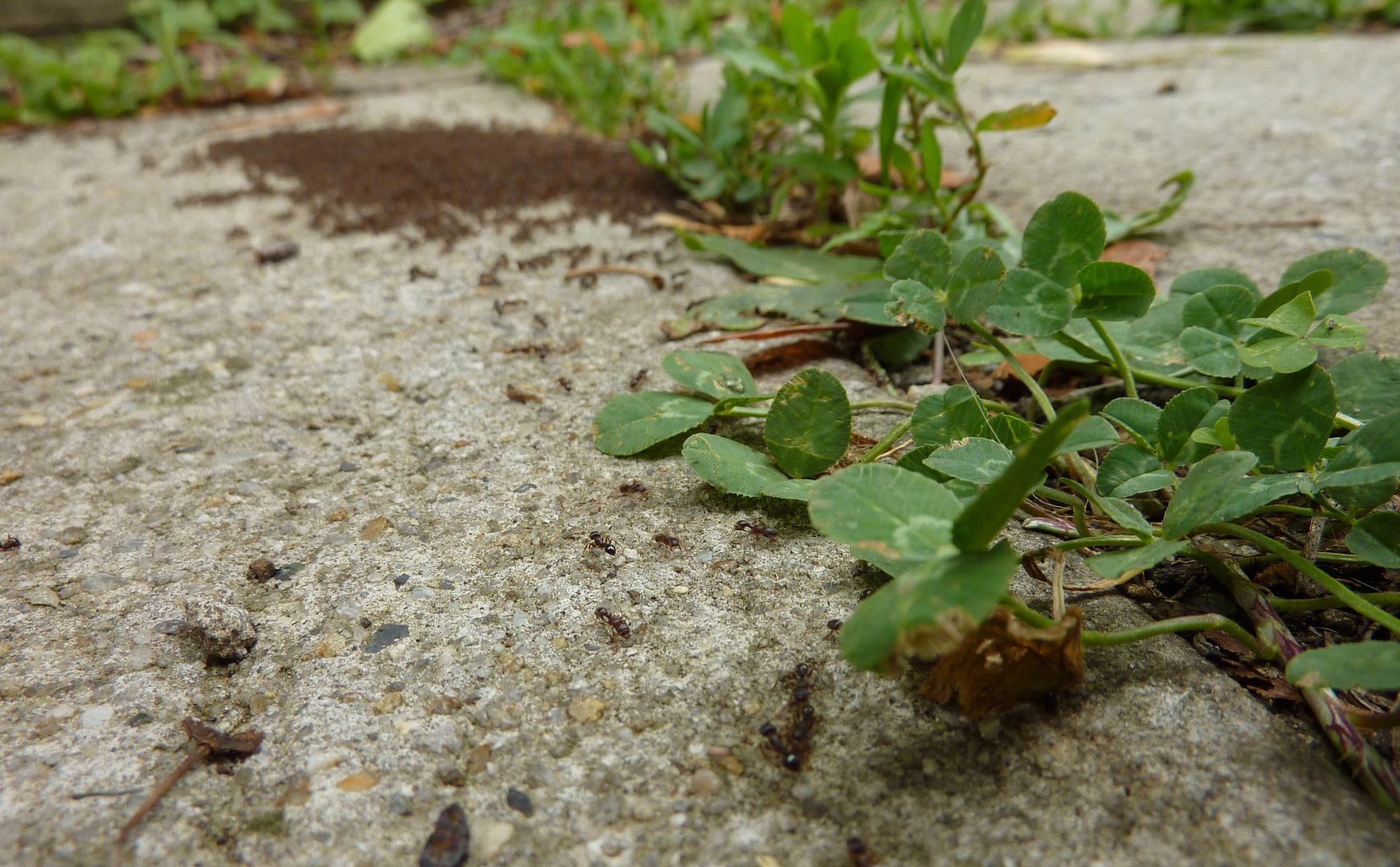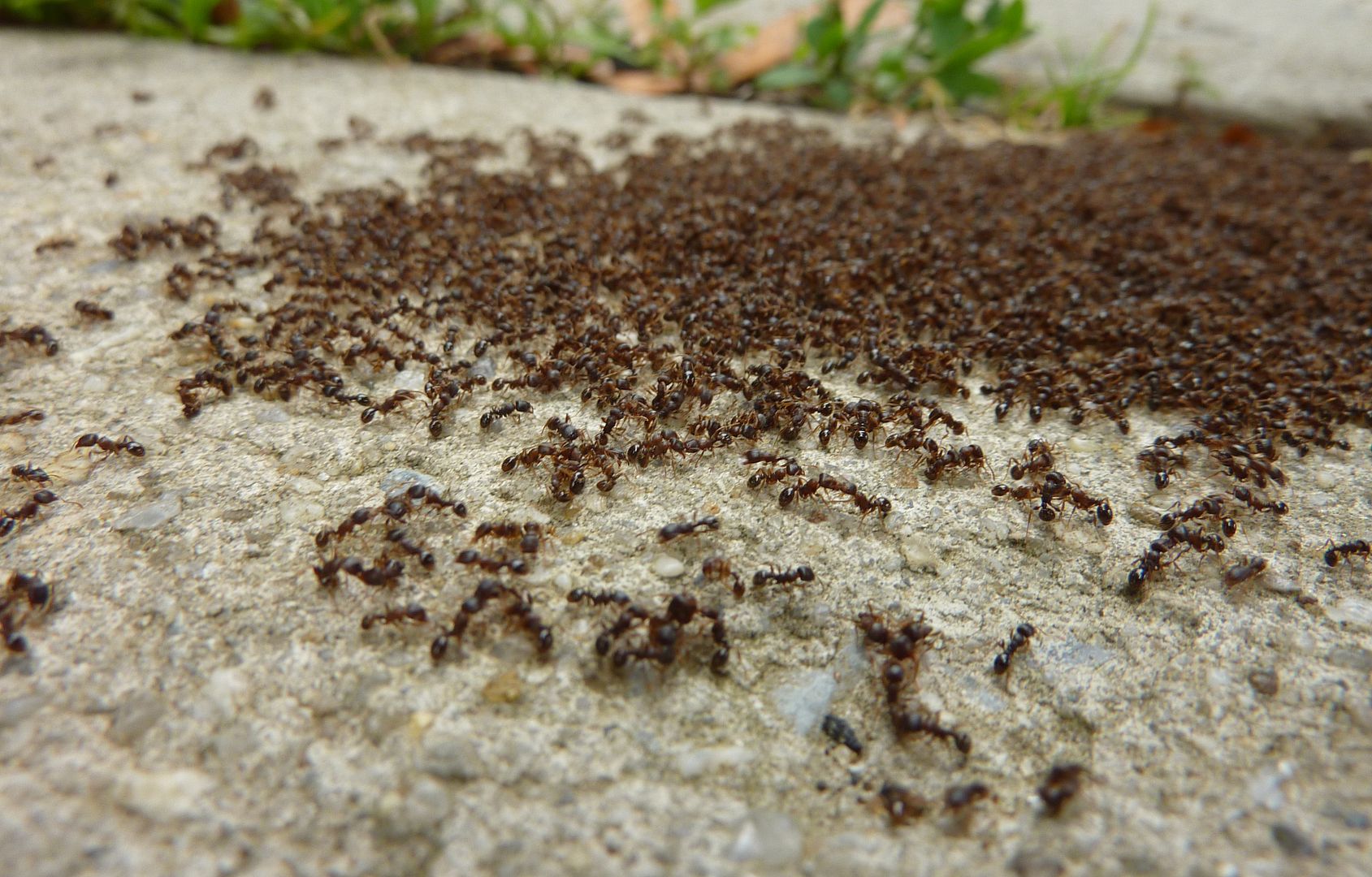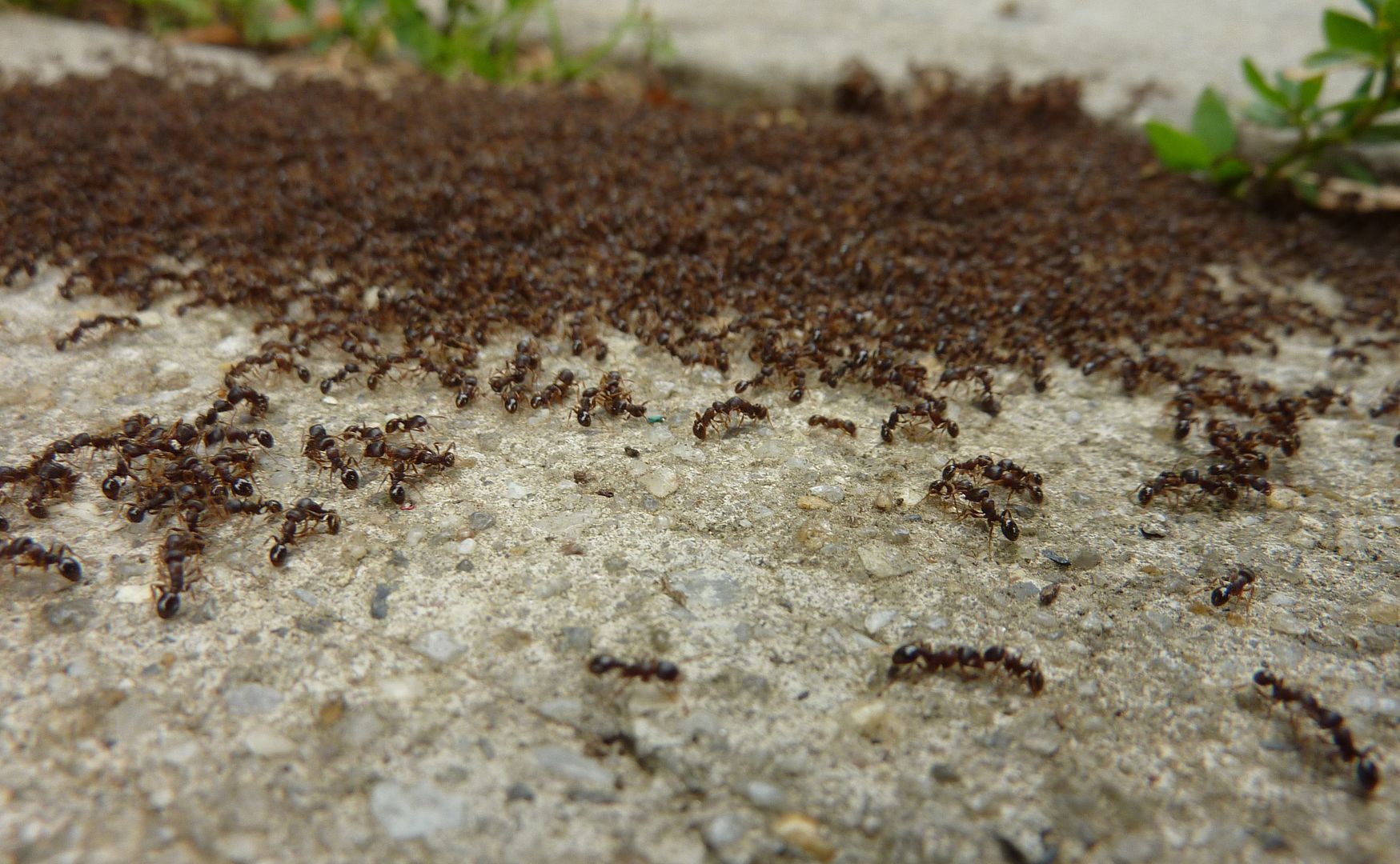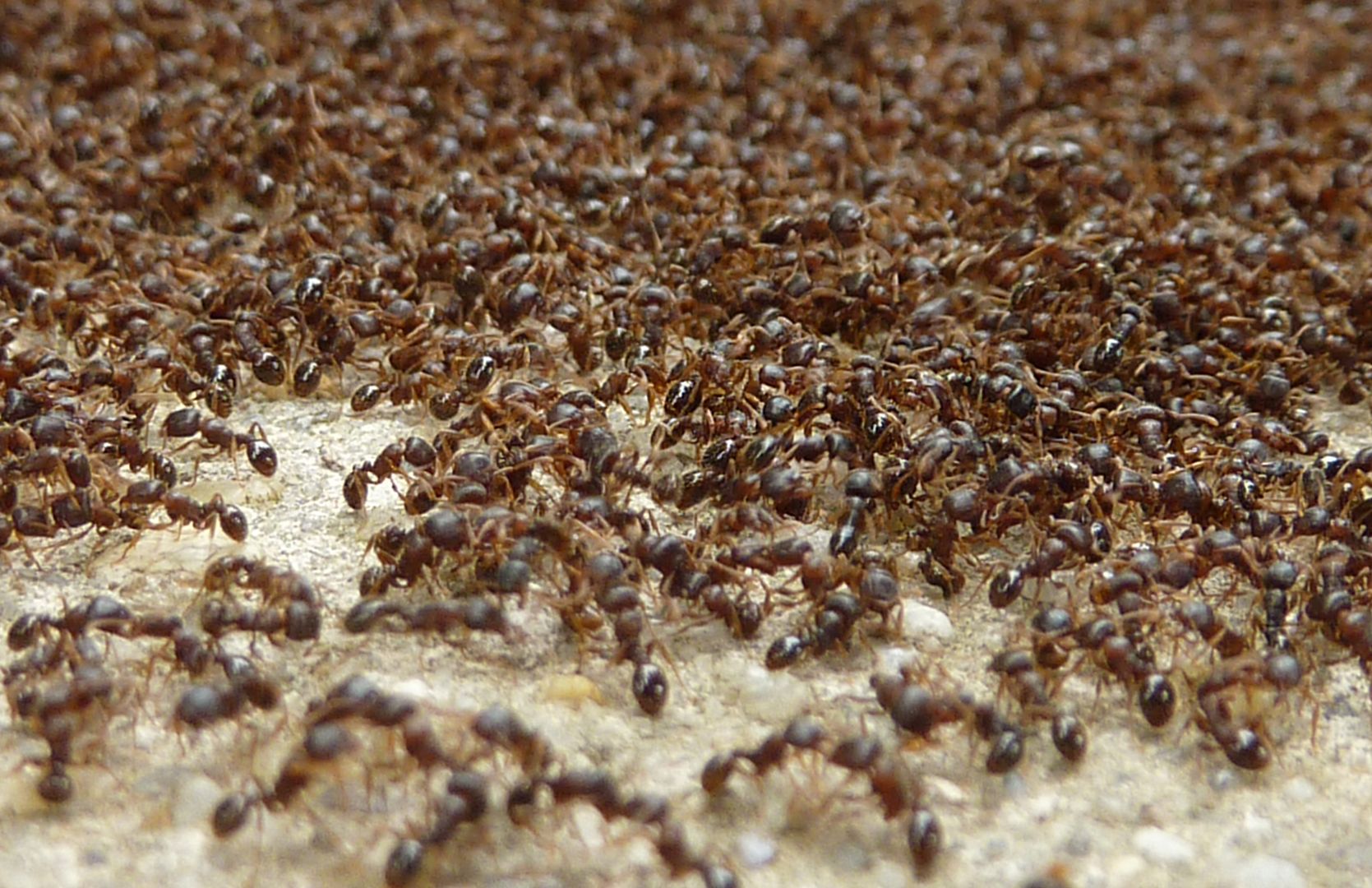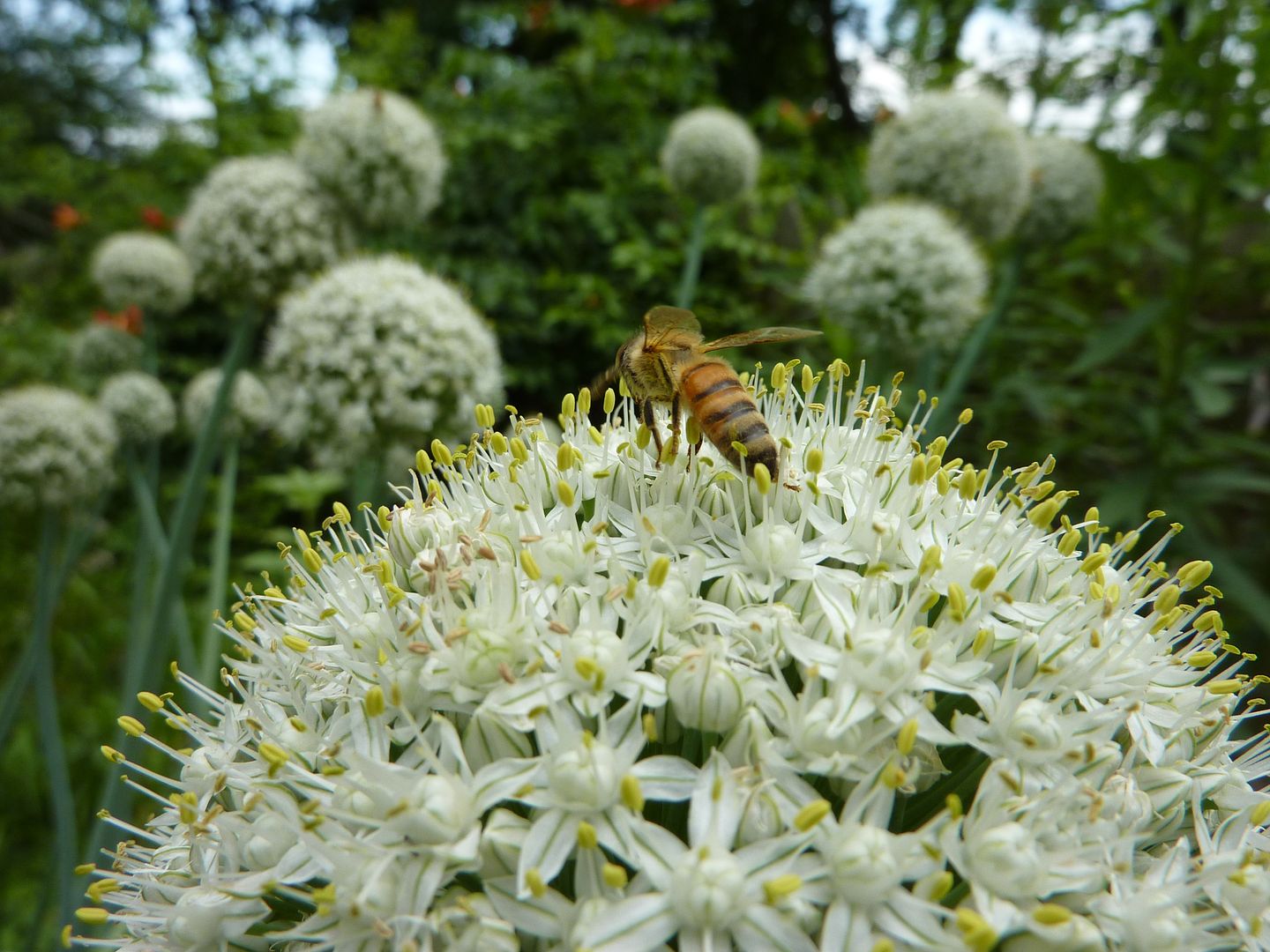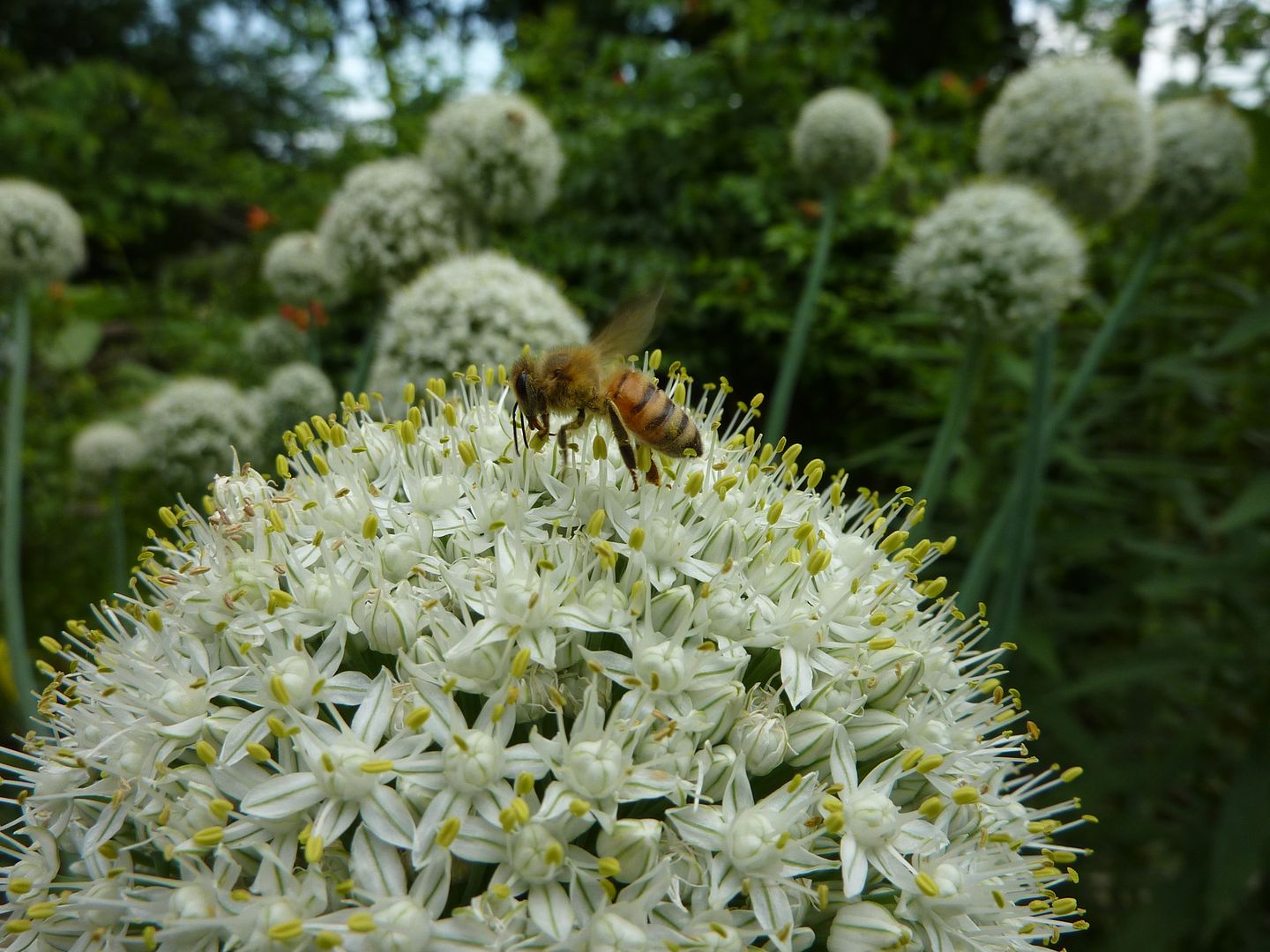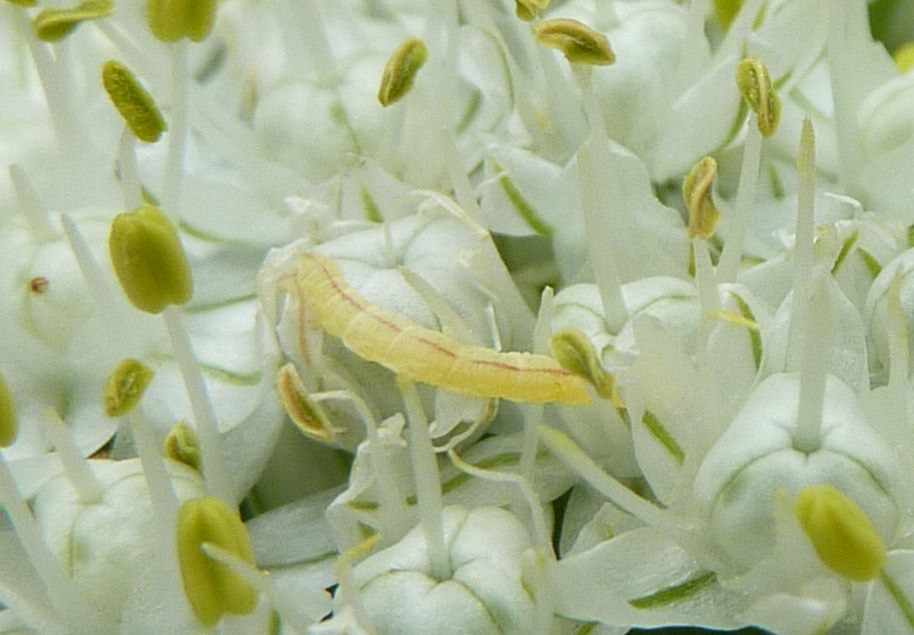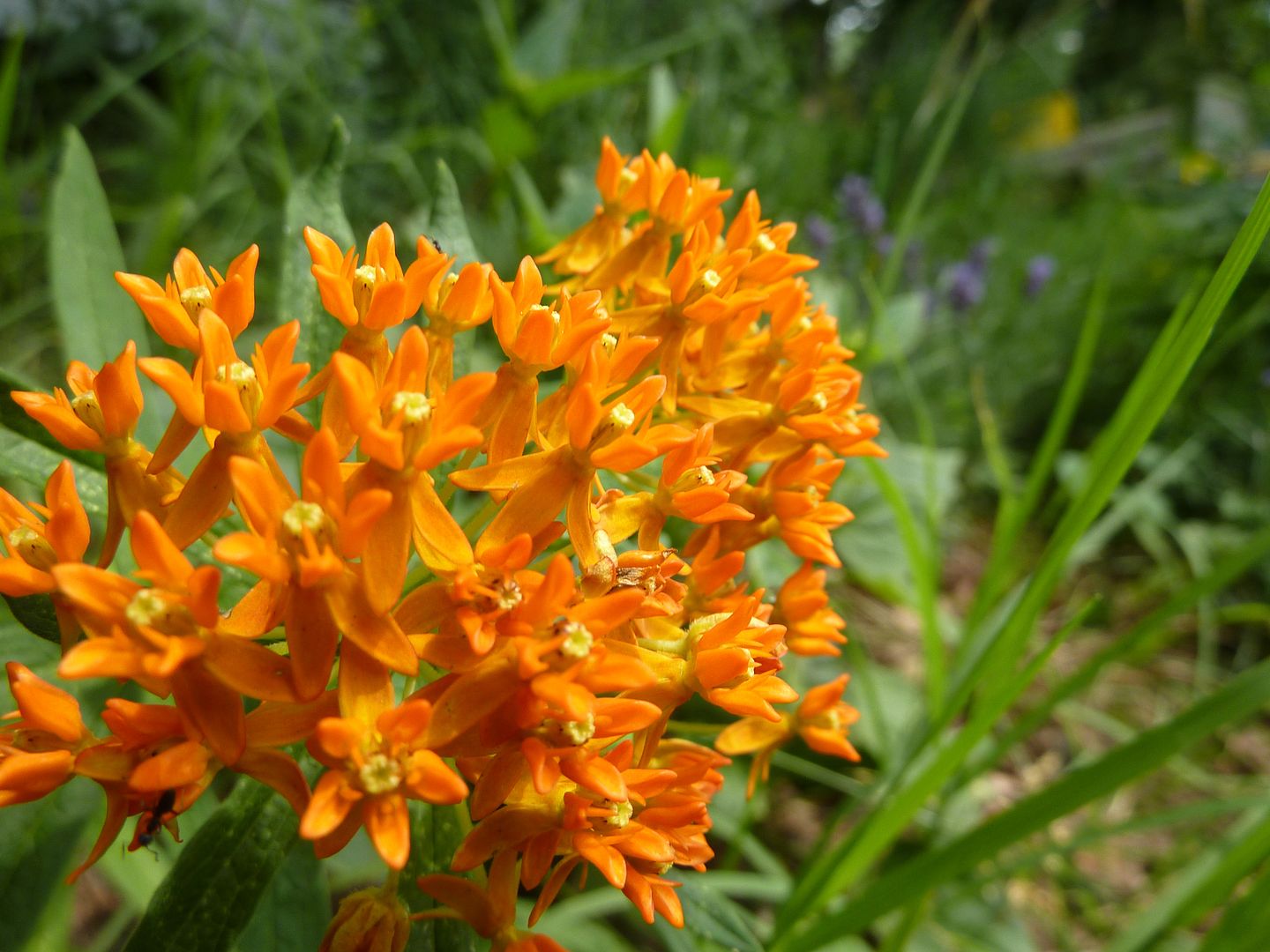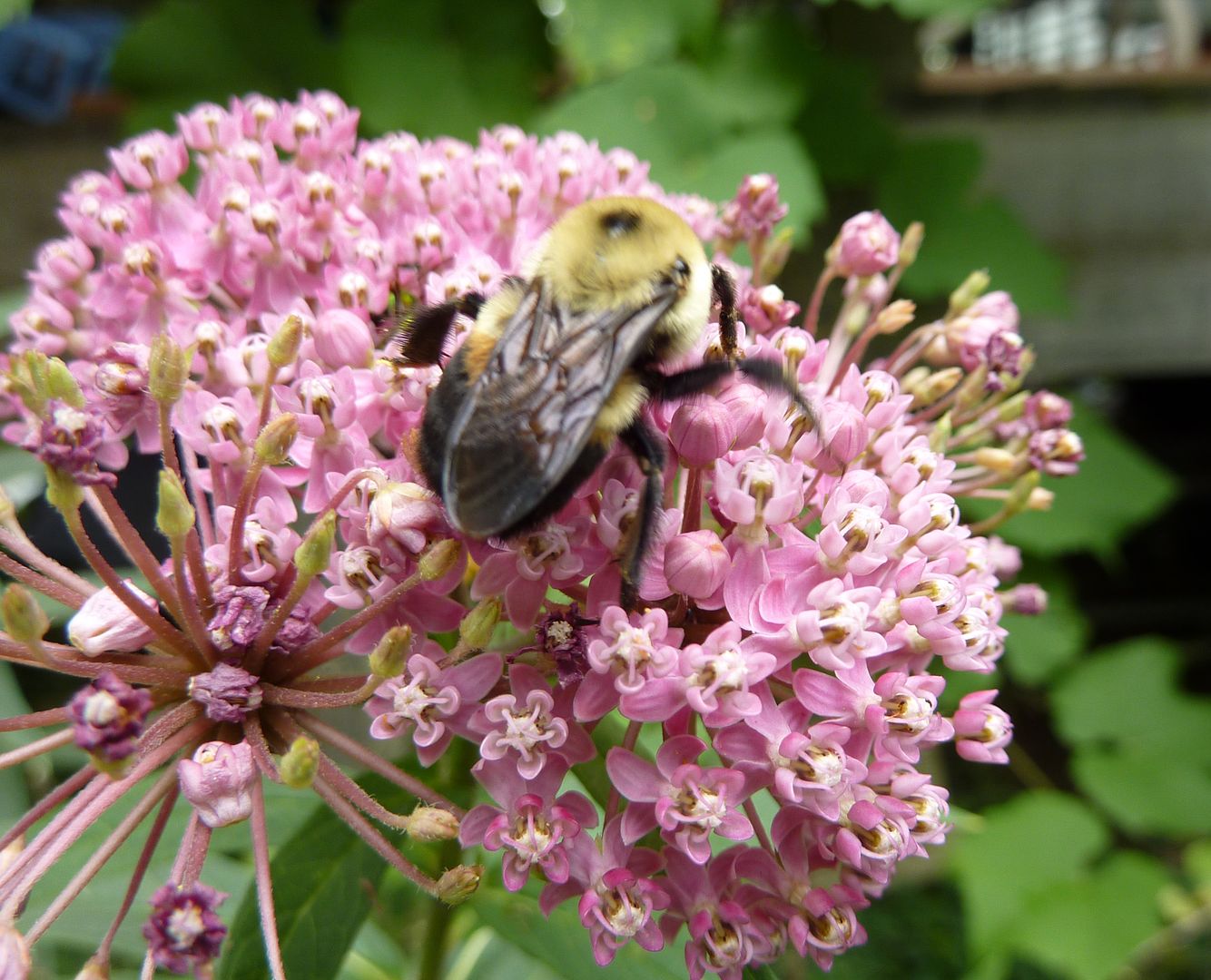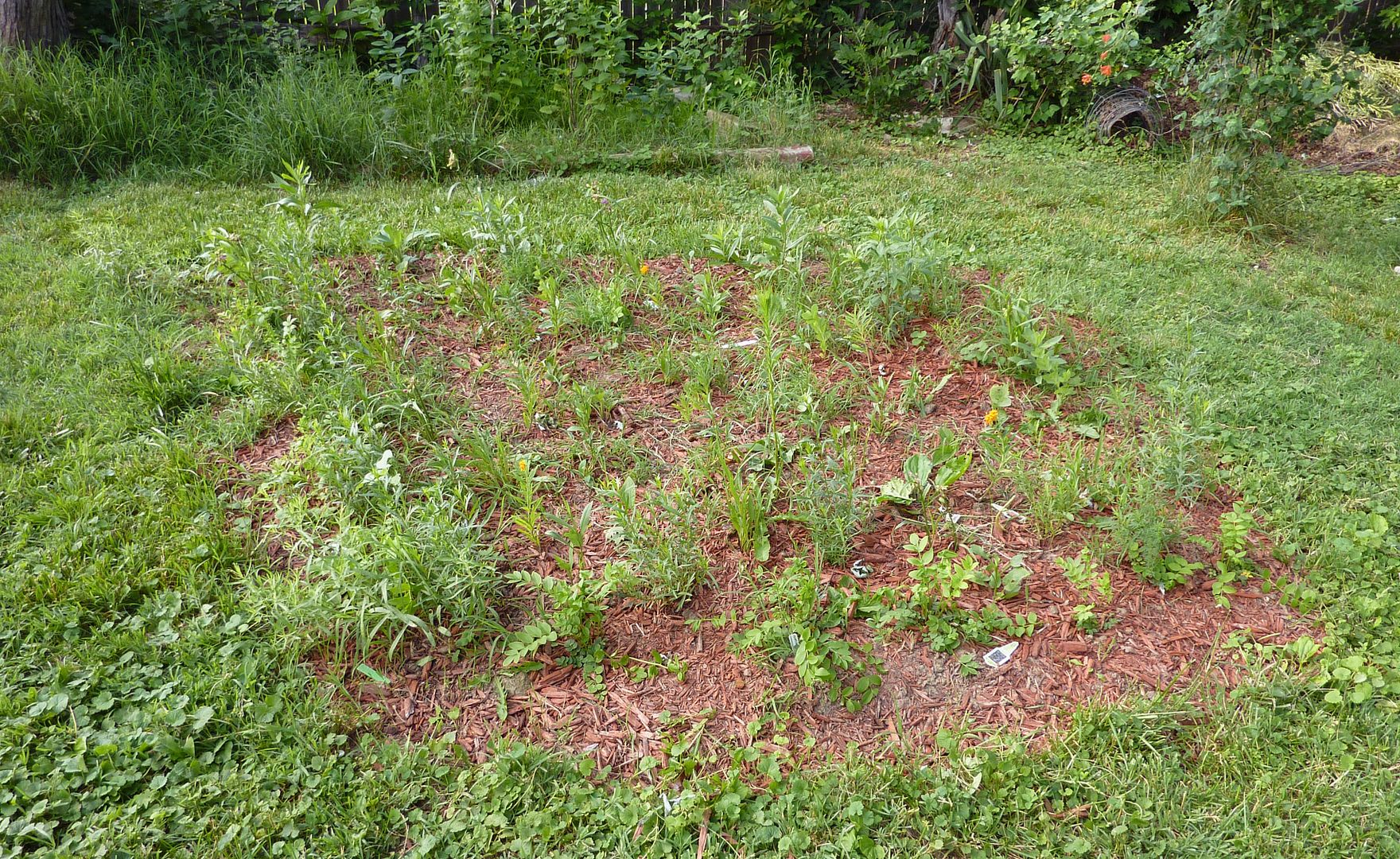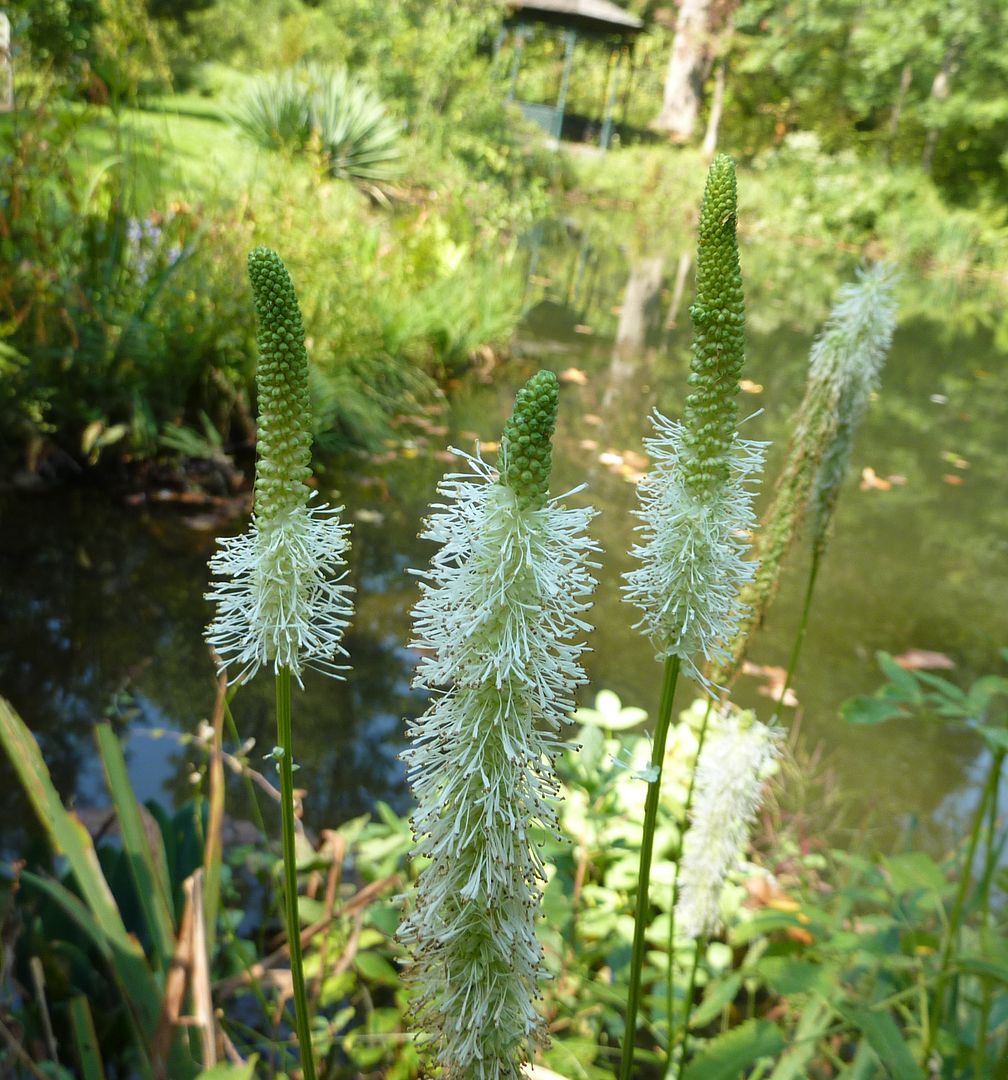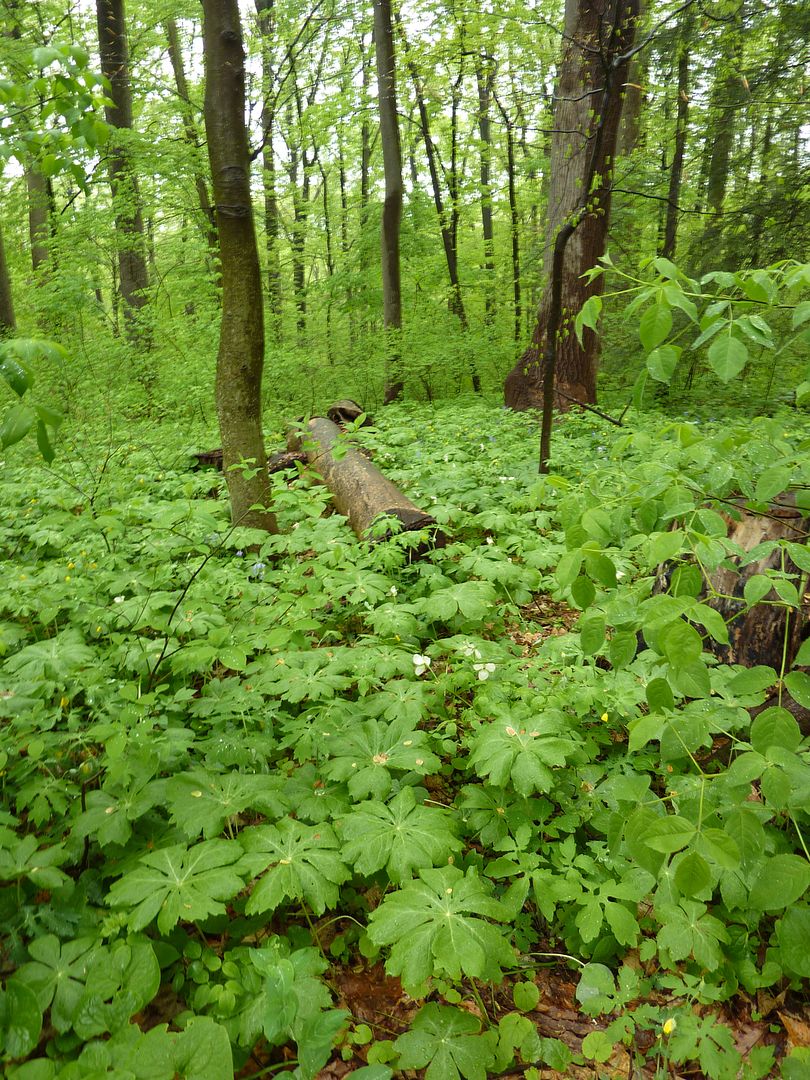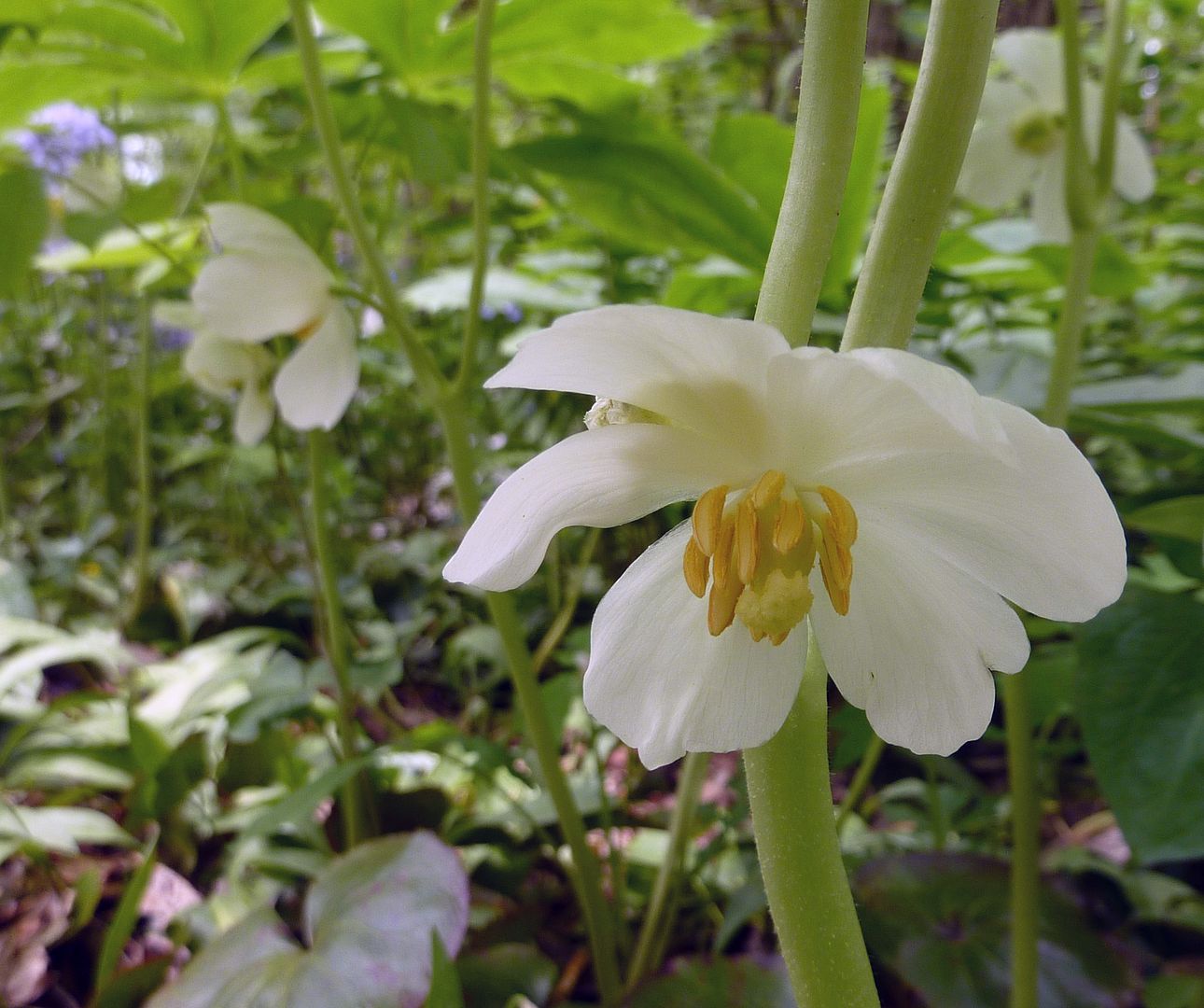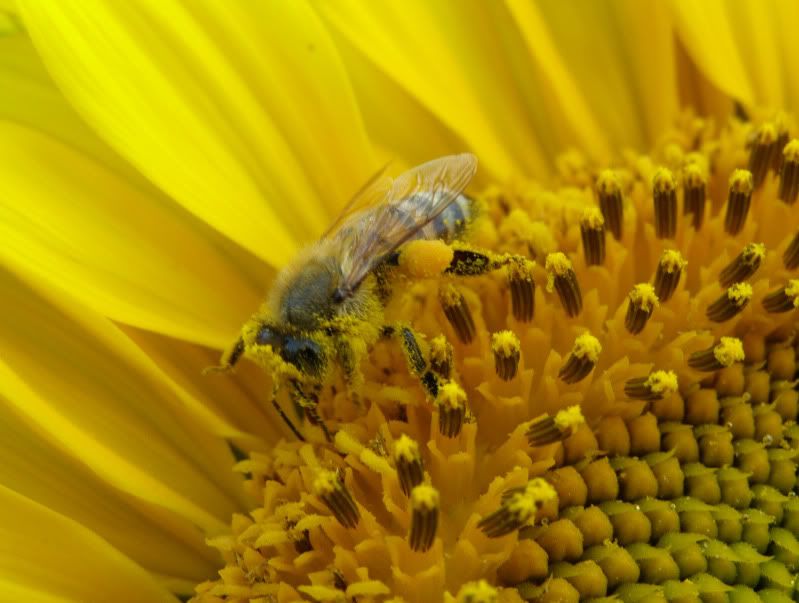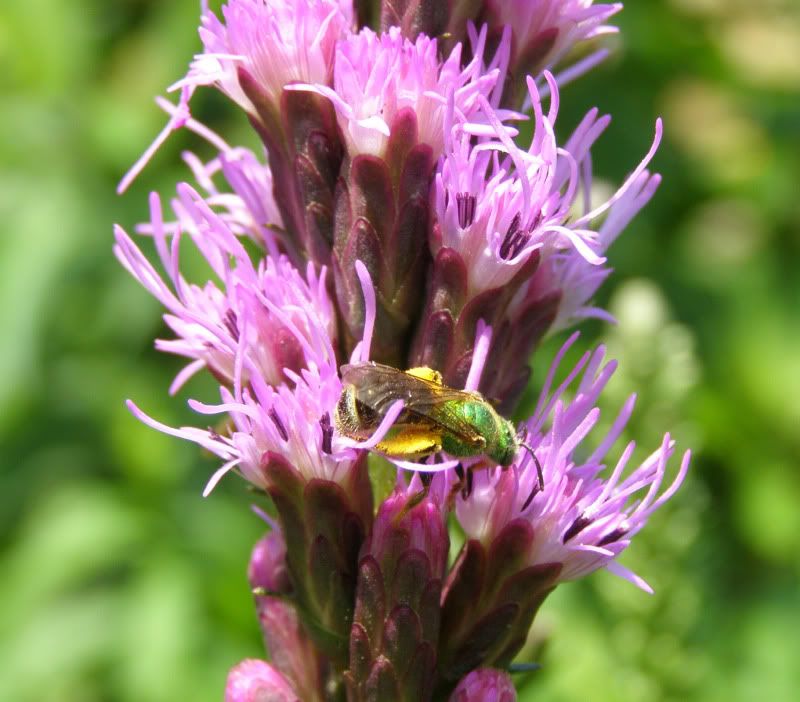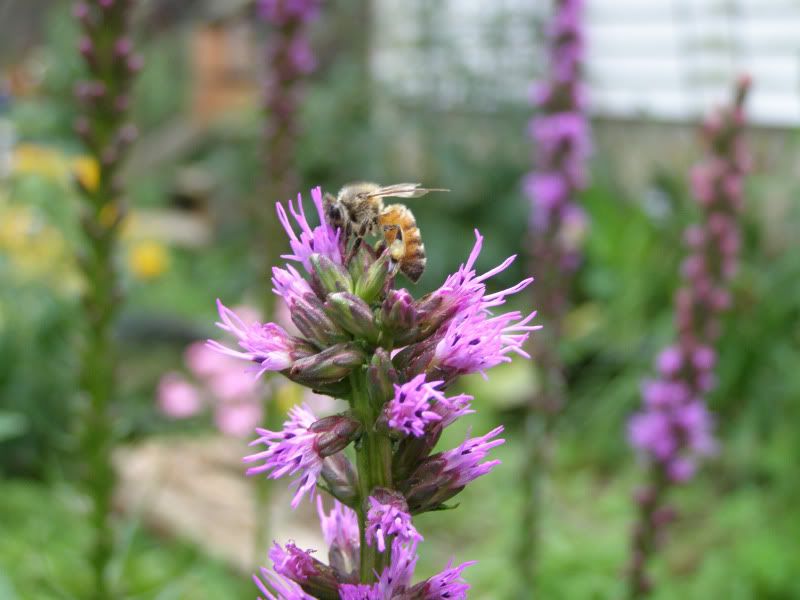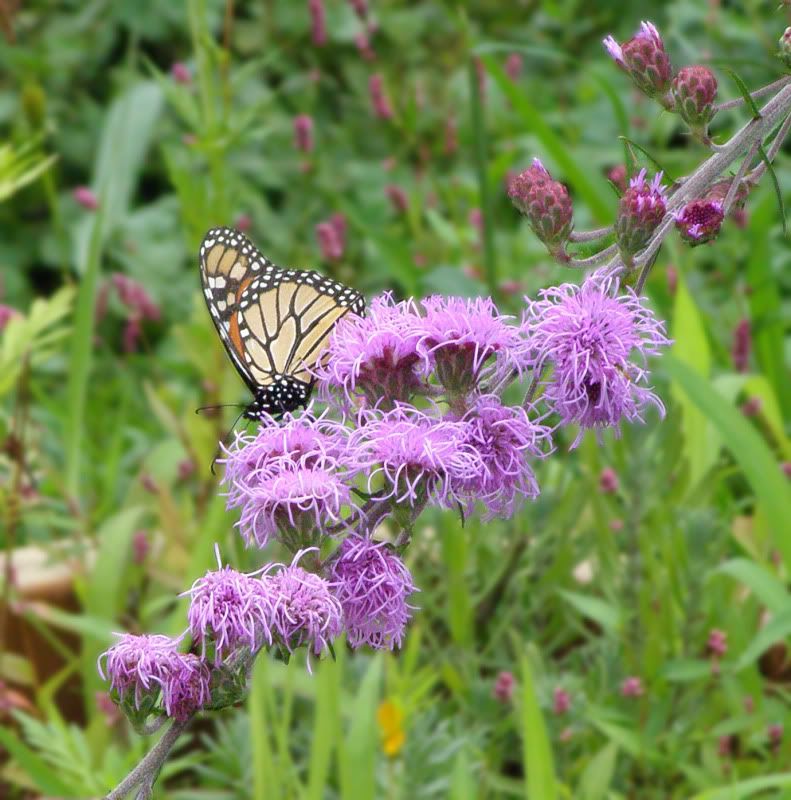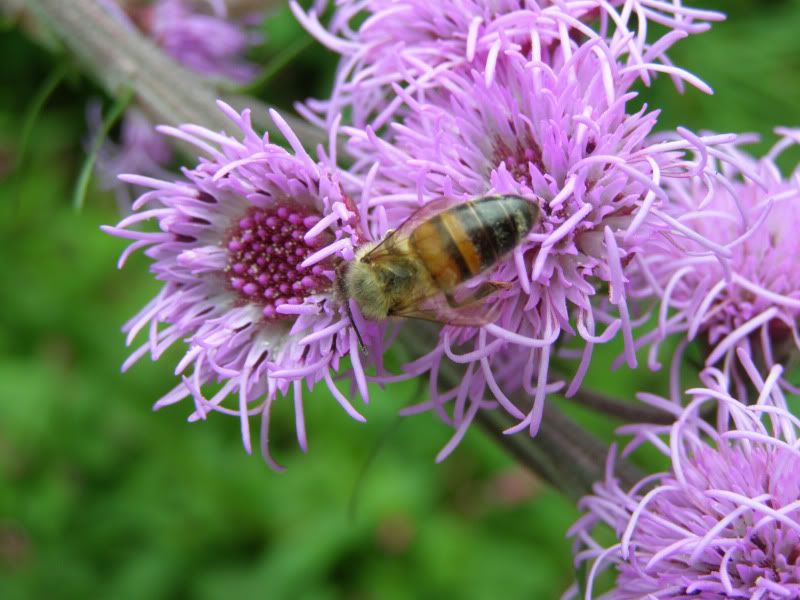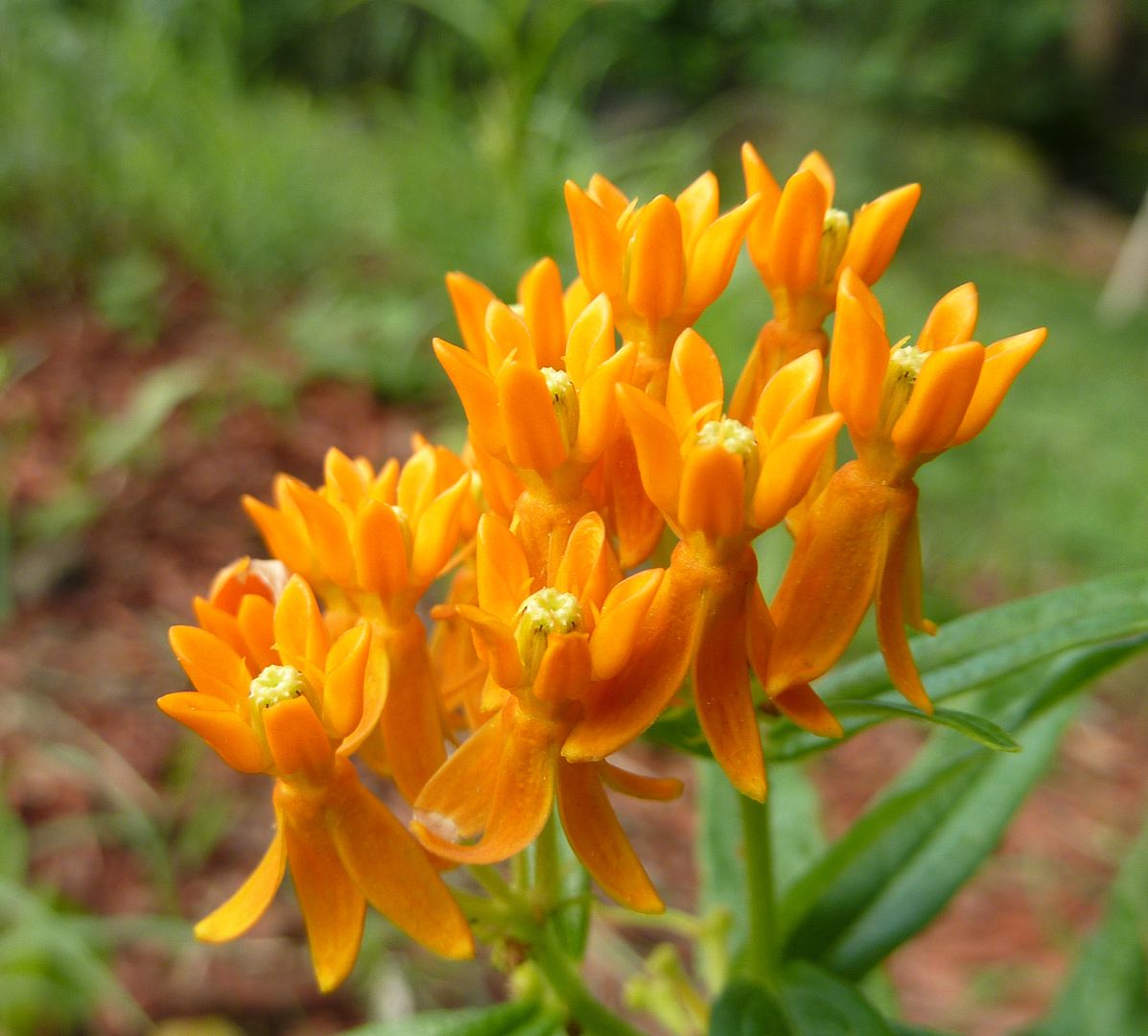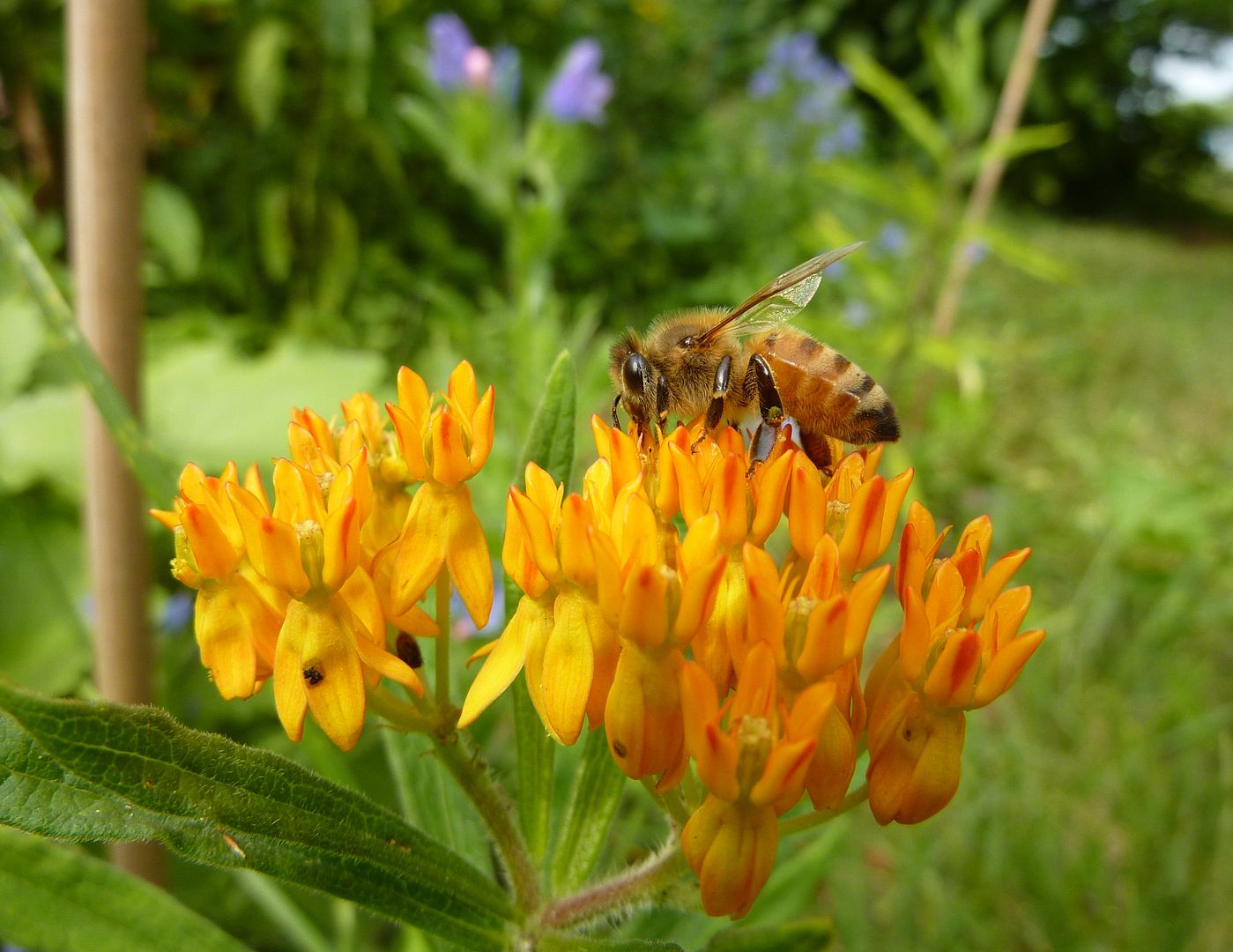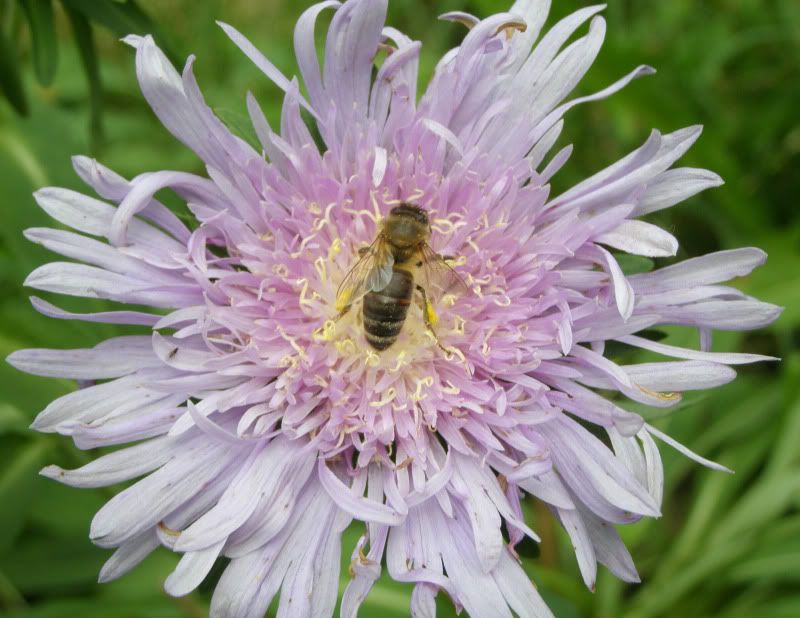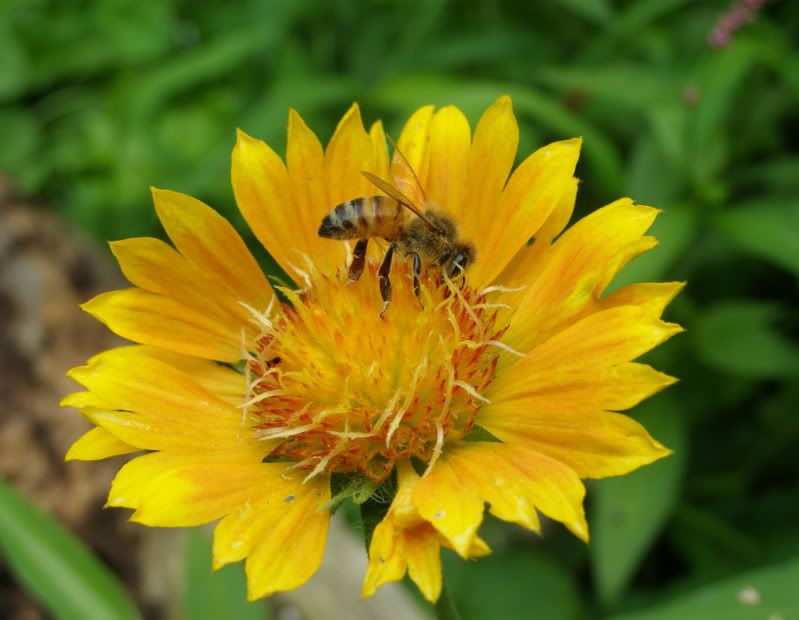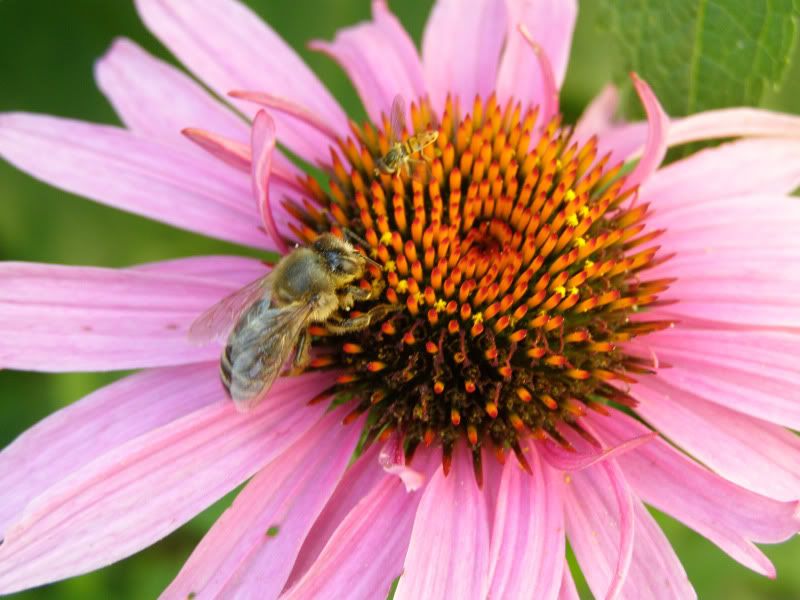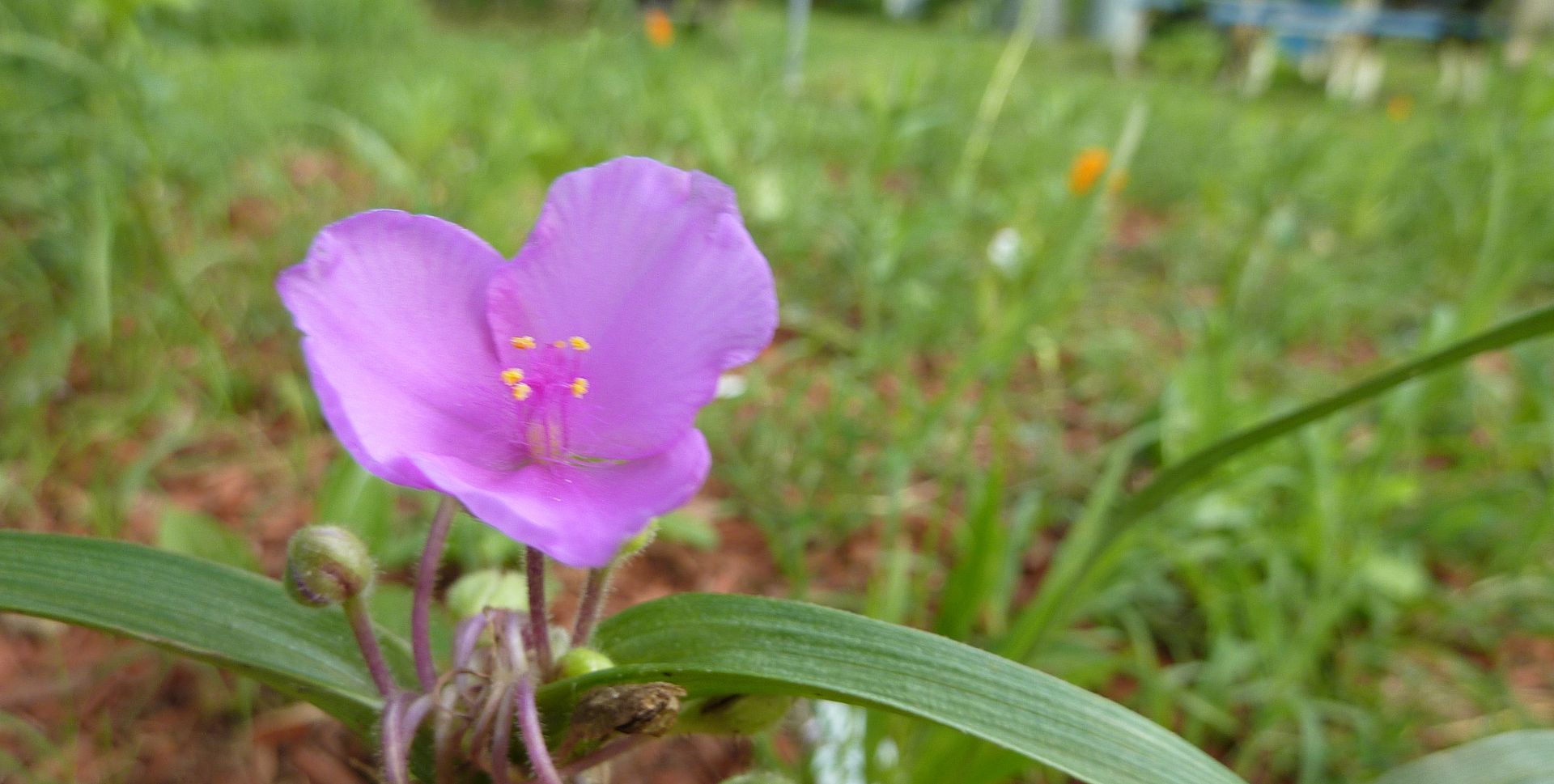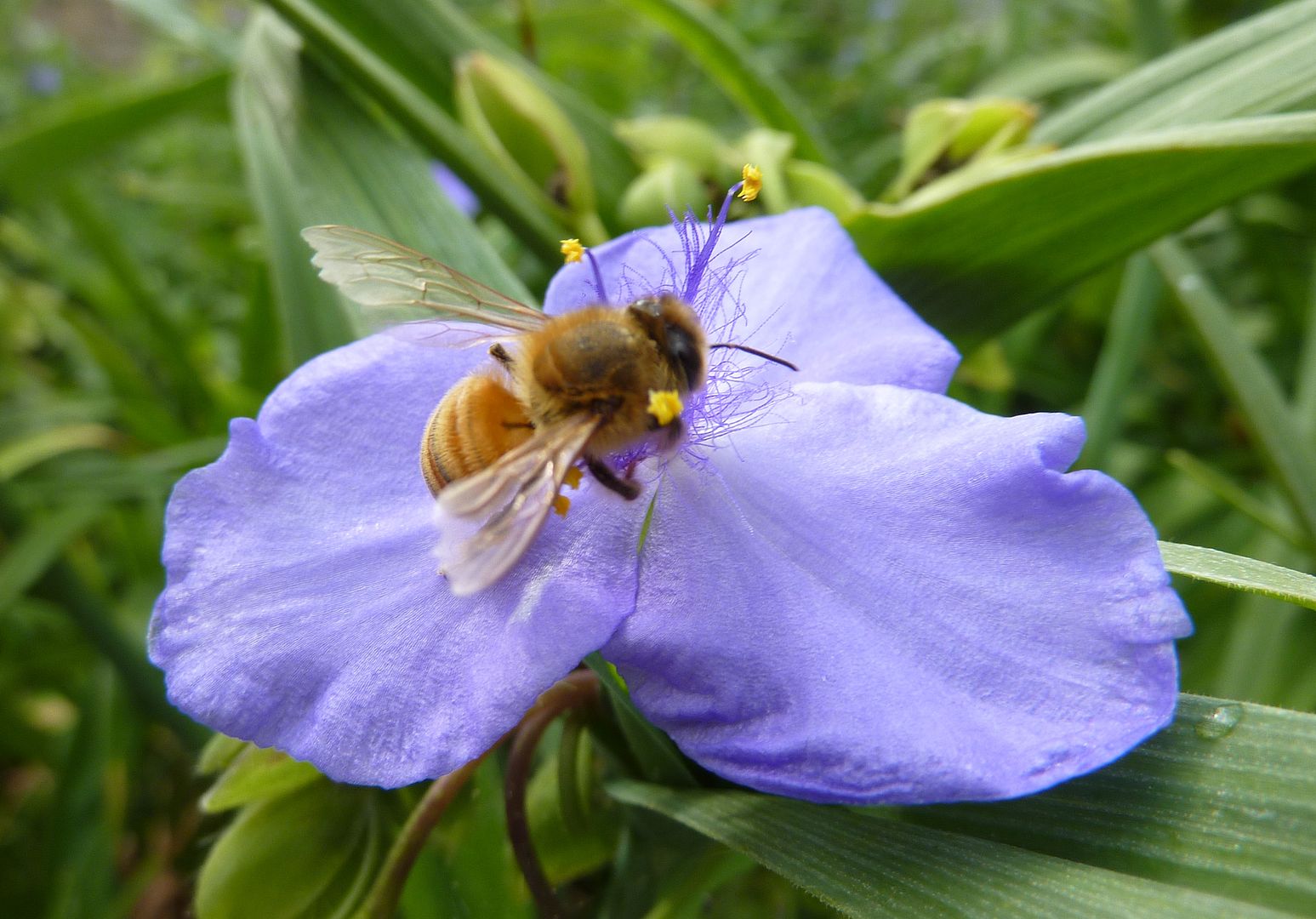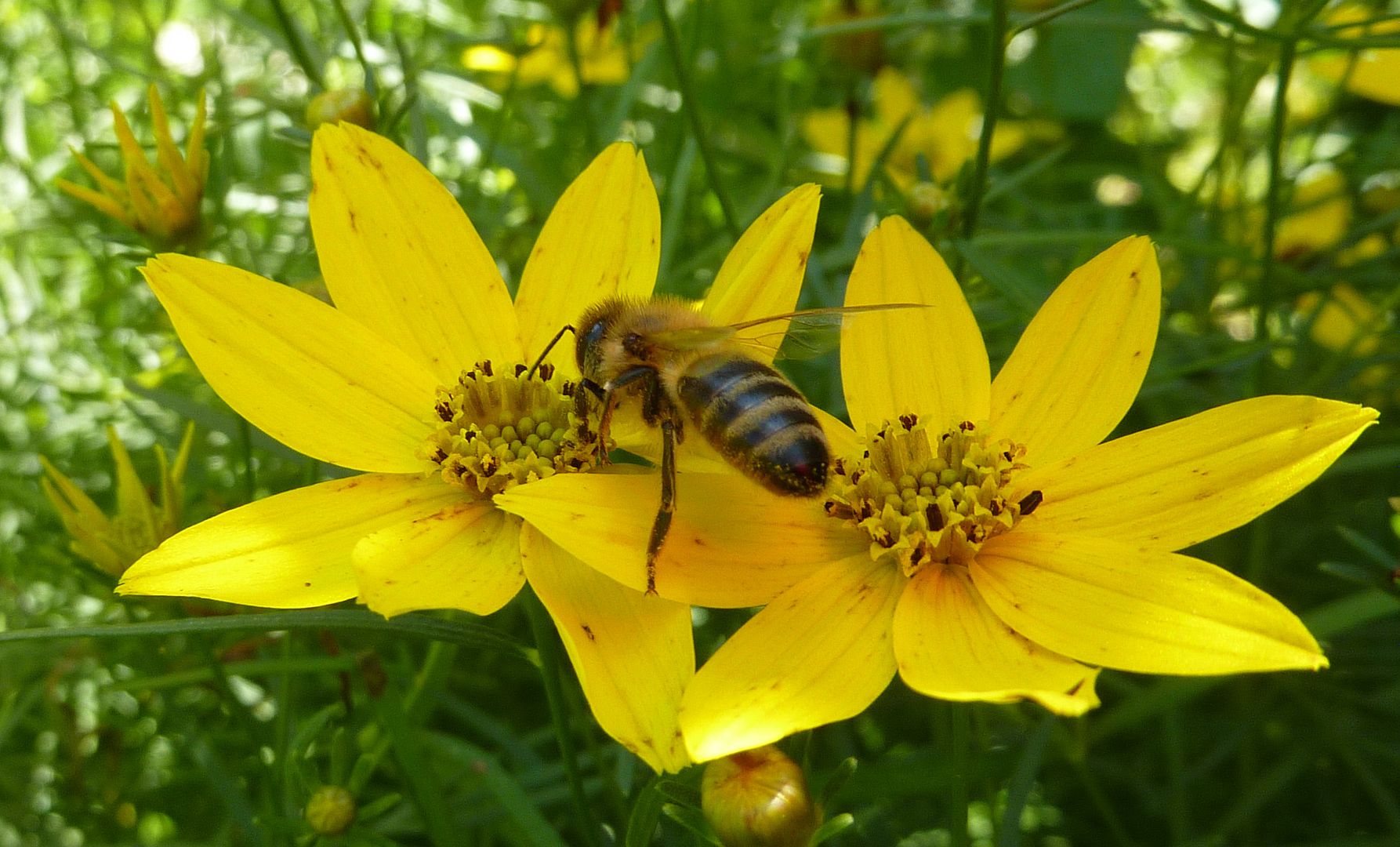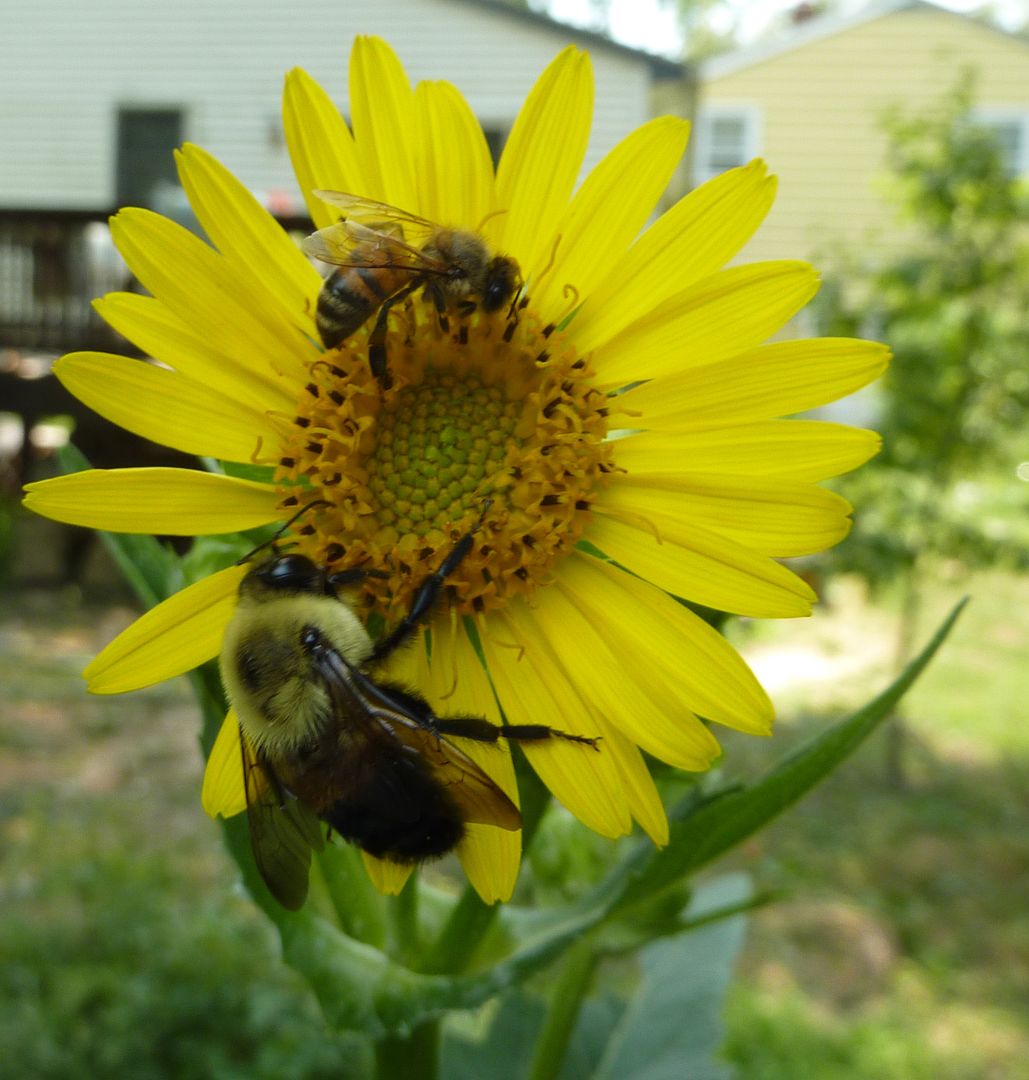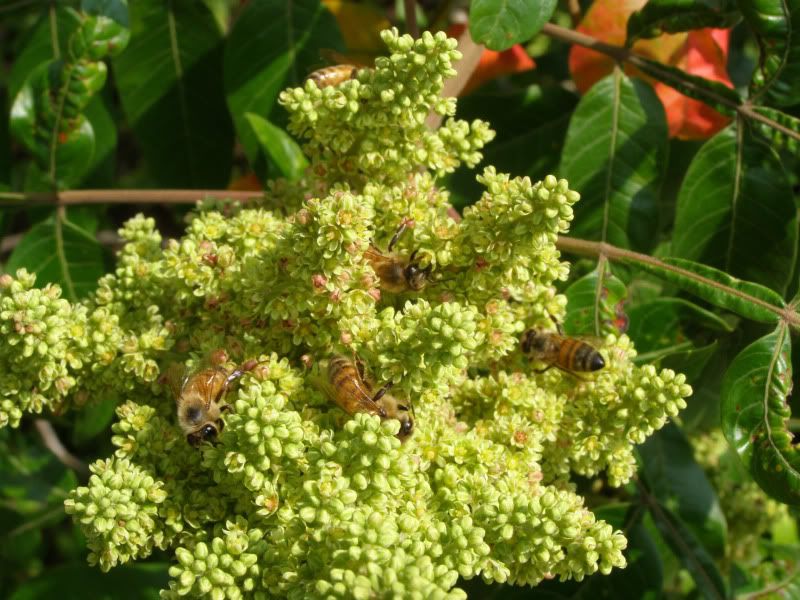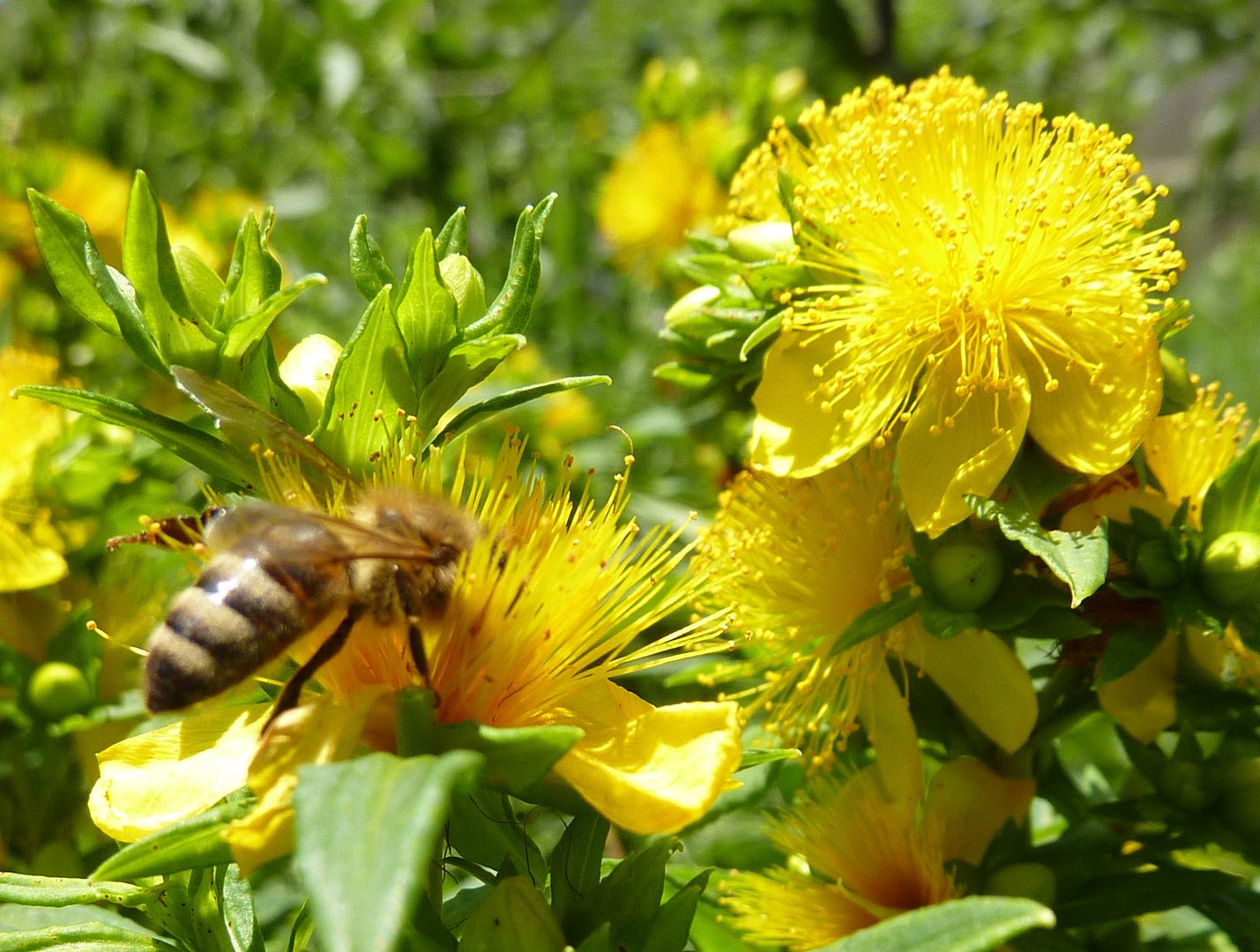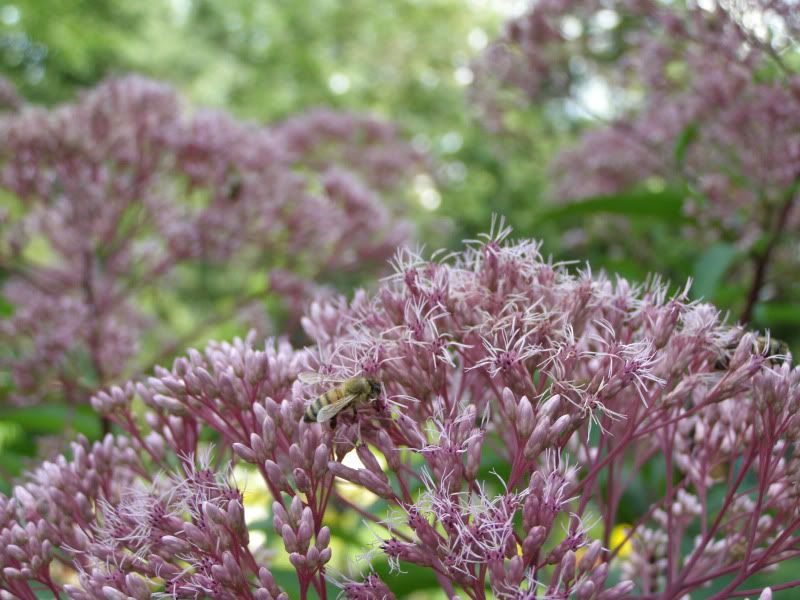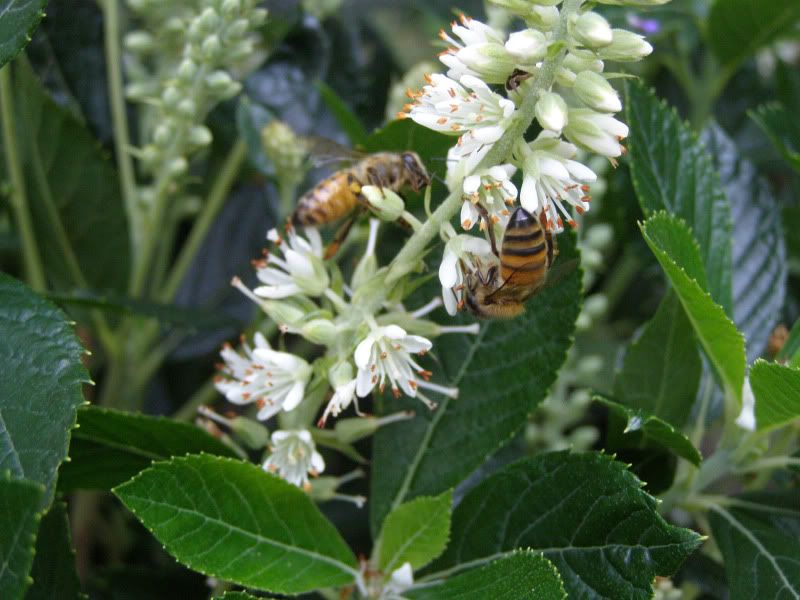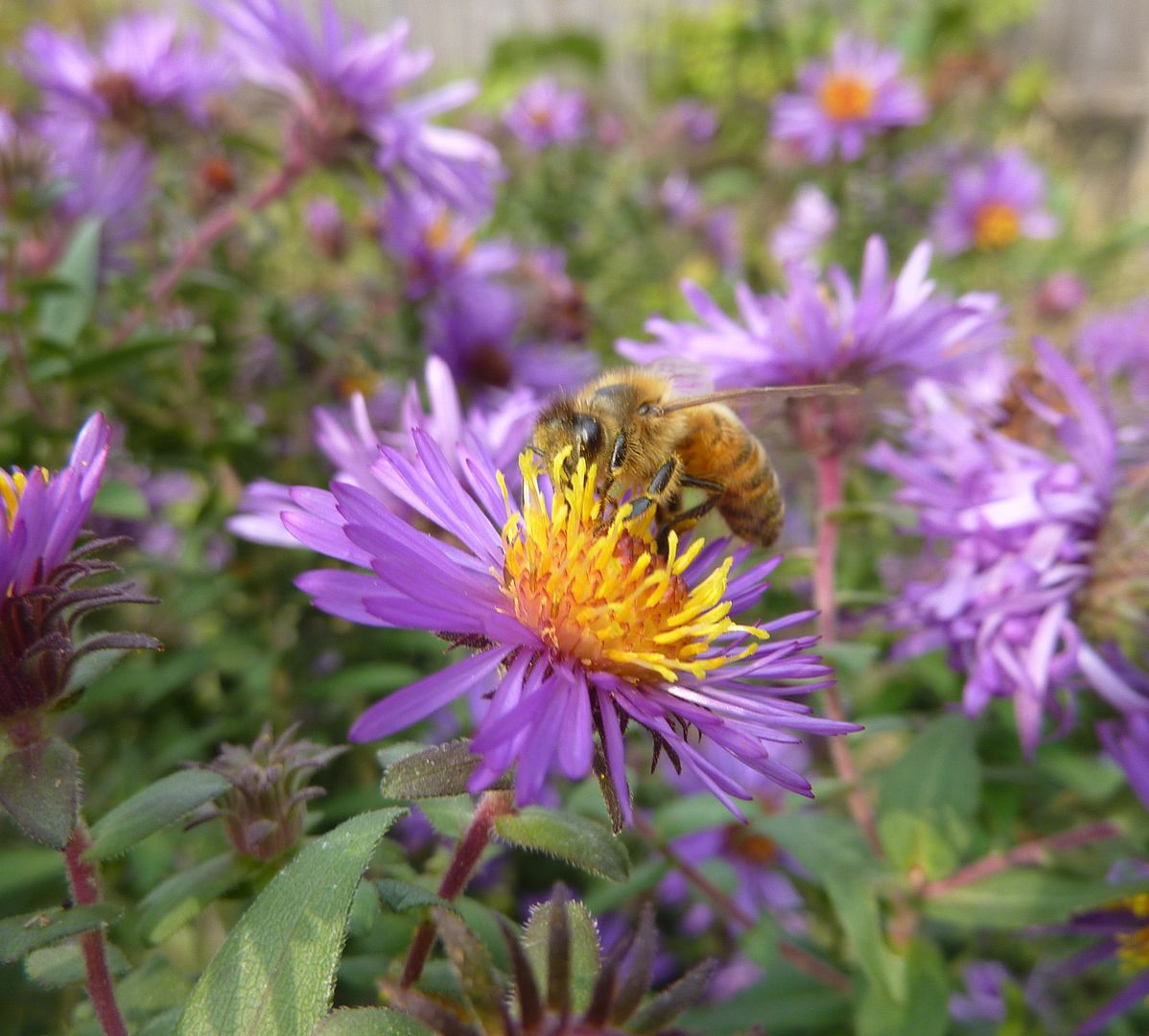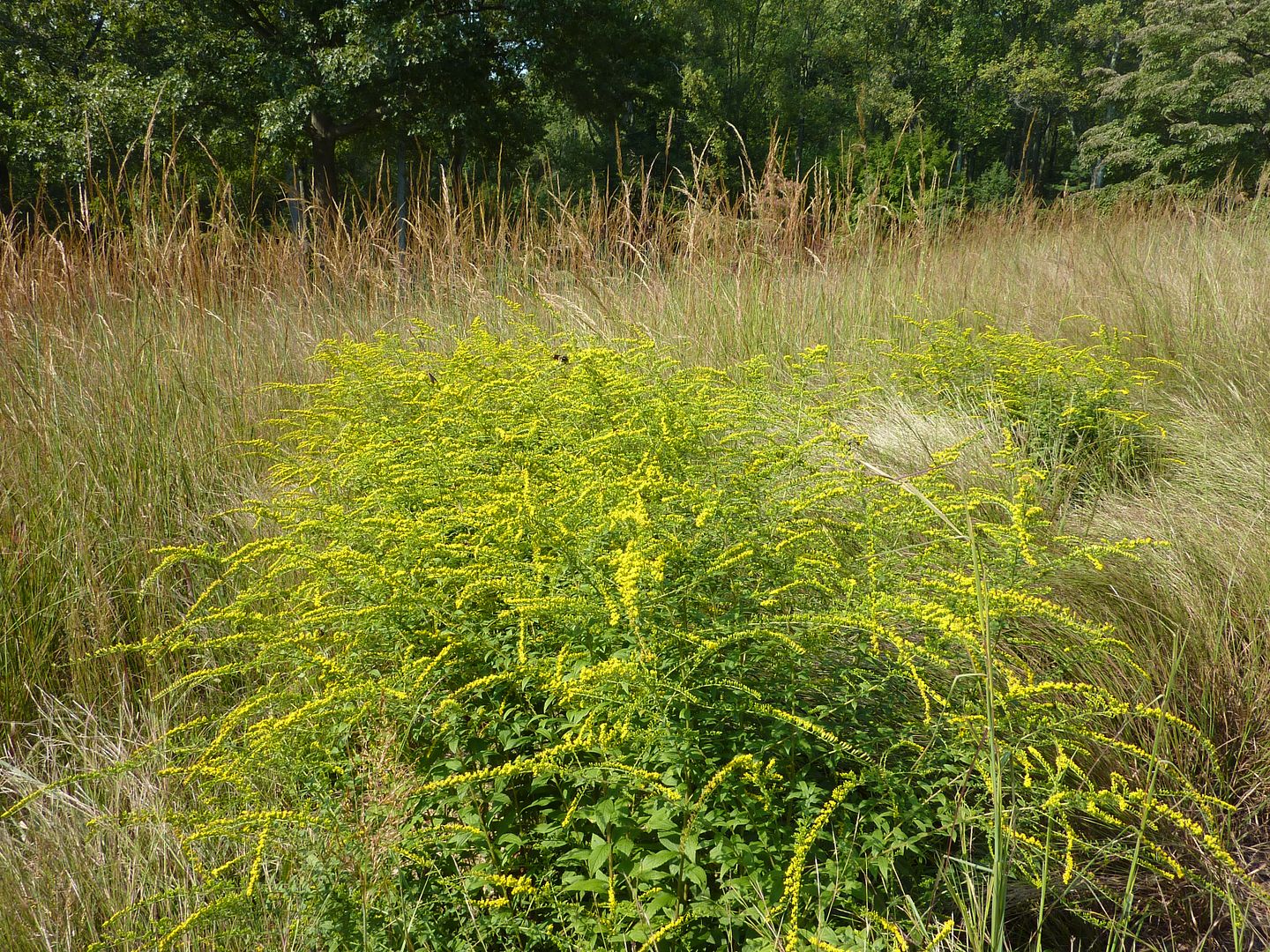We are finally getting over the drought of flowers where I am. Milkweeds have been pretty much the only thing flowering out in the garden, besides what's in the vegetable garden. All the plants that I consider to be the major honey crops of summer currently have buds on them if they haven't already started opening slightly. Assorted Liatris, several types of Joe Pye Weed, Clethera alnifolia, an early blooming Ironweed, Button Bush, Cup Plant, Purple Coneflowers, the shorter varieties of the Perennial Sunflowers, and Anise Hyssop are all approaching their bloom time. Many of these will bloom at their peak for only a week and get replaced by something else which is both a good strategy and makes for a good garden.
Out in the new prairie garden I've planted I'm getting lots of colors. First off using a red mulch was a brilliant idea as it accents the yellow Coreopsis, and orange Butterfly Weed beautify. Some plants that aren't doing so great are the yellow Coneflower, the second species of Coreopsis, and the Purple Prairie Clover. I really don't know what happened to these, it's like something keeps nibbling them to the ground. Hopefully they're just establishing themselves and will pop back next year. The Ozark Coneflowers have leaves but I doubt I'll see any flowers off of them this year.
One of my goals with all this planting has been to help my honeybees through the summer as well as being environmentally conscious. It's a lot harder to do both as environmentalists view the nonnative honeybee's foraging as stealing food from our native bees. I argue though that honeybees are easily distracted by food sources and a diverse garden should offer plenty in the way of food for everything. This is a serious issue with certain plants who can only be pollinated by a single species of indigenous bee, but I don't have any of those plants here. Even if next year my honeybees are hogging all the Milkweed and Anise Hyssop there are other things flowering here for native bees to work.
Traditionally I've tried to harvest honey around the same time the Joe Pye Weeds bloom. I think this usually happens in late July. I may do another video on it but I feel the previous one I did was a good production. Bee Chat Harvesting Honey.
Thursday, June 30, 2011
Sunday, June 26, 2011
Camponotus Nesting Habits
For the past two years I've been finding random Camponotus chromaiodes workers exploring plants out in the garden. The location gets very few ant colonies; as the soil is poorly drained, it naturally floods into a small puddle every time it rains. Waterlogged soils are awful for ant nests. Always though I would find the one worker to this species roaming about the perennial sunflower and small rose bush.
The only real ants I find there are all opportunistic nesting. Nylanderia flavipes, Temnothorax, and a few of the smaller Camponotus species that live happily in hollow plant stems from adjacent foliage. There is a reasonably sized log I use as a boarder for the garden, but upon lifting it up I find nothing there. In truth I've thought about replacing the log because it's gotten so water rotted that half of it sticks to the ground, I assume from fungi. The obvious place to look is inside the log but such snags are hard to come by and I'd like to keep it in tact as I kind of built the garden around it... then fate intervened.
Pictured here are two common species of Camponotus. Up top is Camponotus pennsylvanicus which is solid black in color and only nests in dead wood, the softer the better. Down below is Camponotus castaneus which is almost a glowing orange yellow color that nests in soil, typically within a forest.
Soil nesting species for whatever reason have shed the darker colors of their wood nesting cousins. This trend seems to apply for all of the Camponotus species in North America, at least the larger ones that is.
Species that are mixed in color, such as Camponotus chromaiodes, have the option to nest in either soil or wood, and often do both. I believe young colonies favor wood before moving into soil though.
Now because a lot of Camponotus nest in dead wood, often their colonies are found "down hill" as dead wood typically rolls down hill over time. It would be interesting to see weather the species that nest in both soil and wood, bother to nest in soils that are poorly drained, or weather this is only an upland habit.
So I left the C. chromaiodes colony to rebuild in their log. They swiftly moved the queen and all their brood to what I assume used to be an entrance tunnel. Hopefully I'll continue to see them in the garden. It is always nice having colonies to check on easily so I have an idea of what to expect out in the wild. It is unfortunately that discovering of colonies can sometimes be destructive though.
The only real ants I find there are all opportunistic nesting. Nylanderia flavipes, Temnothorax, and a few of the smaller Camponotus species that live happily in hollow plant stems from adjacent foliage. There is a reasonably sized log I use as a boarder for the garden, but upon lifting it up I find nothing there. In truth I've thought about replacing the log because it's gotten so water rotted that half of it sticks to the ground, I assume from fungi. The obvious place to look is inside the log but such snags are hard to come by and I'd like to keep it in tact as I kind of built the garden around it... then fate intervened.
I had a friend over and lifted the log up for him, only to have it snap in half while I heaved. All the dampness has turned the wood soft and sponge-like. So there was the main brood chamber, and queen spilling out between the two halves of the log. So I feel I should take this opportunity to exercise a point.
Pictured here are two common species of Camponotus. Up top is Camponotus pennsylvanicus which is solid black in color and only nests in dead wood, the softer the better. Down below is Camponotus castaneus which is almost a glowing orange yellow color that nests in soil, typically within a forest.
Soil nesting species for whatever reason have shed the darker colors of their wood nesting cousins. This trend seems to apply for all of the Camponotus species in North America, at least the larger ones that is.
Species that are mixed in color, such as Camponotus chromaiodes, have the option to nest in either soil or wood, and often do both. I believe young colonies favor wood before moving into soil though.
Now because a lot of Camponotus nest in dead wood, often their colonies are found "down hill" as dead wood typically rolls down hill over time. It would be interesting to see weather the species that nest in both soil and wood, bother to nest in soils that are poorly drained, or weather this is only an upland habit.
So I left the C. chromaiodes colony to rebuild in their log. They swiftly moved the queen and all their brood to what I assume used to be an entrance tunnel. Hopefully I'll continue to see them in the garden. It is always nice having colonies to check on easily so I have an idea of what to expect out in the wild. It is unfortunately that discovering of colonies can sometimes be destructive though.
Tetramorium War: Battle of the Driveway
Pavement Ants are a common invasive in North America. They like disturbed habitats, typically with a low diversity of plant life, with plenty of access to full sun (6 hours or more per day), typically with access to logs and stones who's heat assists with the incubation process. Colonies can get massive, upwards of 80,000 individuals, that all come from a single queen.
Despite one common name, there are two species of Pavement Ants to look out for in North America (11 in total but most are restricted to the south west). Tetramorium tsushimae and Tetramorium species E. are the main ones found in the US, though which one you have makes little difference. Both are virtually identical. Don't let the links to antweb in this paragraph fool you; you're looking at a fraction of the total diversity within a colony. I'm not even sure I linked to the correct T. species E. In North America for the past ~180 years both species were simply assumed to be Tetramorium. caespitum. That species is only found in Europe, so what we have in North America has been found, mostly through DNA I think, to be the two species linked above. Now species E. doesn't match up properly with anything but it's generally known that it's not native. So the species name seems to be in limbo until someone figures out what is going on.
In short, though, they're pavement ants. T. species E. is typically .5mm longer than T. tsushimae and more often than not, T. species E. is uniformly black or dark brown. T. tsushimae tends to be smaller, and has a lighter mesosoma (middle body segment). Both traits of which vary within a colony. As I said though it makes little difference.
A fun aspect these species have is how territorial they are even among the same species. Assuming they're present in your neighborhood, it should be easy to find one of their wars happening with a reasonable walk to your local park or playground of choice.
As mentioned, these ants love rocks and logs for incubation and they nest in places (typically lawns) that have very low resources. They're not the worst invasive because they more or less displace native species as opposed to taking this kind of aggression and putting towards their enemy. Really I think they ignore all other ant species except their own or other Tetramorium. That said, they will still harass other species right out of their territory as they fight to take over structures for incubating their brood.
With competition so high for land these kinds of battles are epic, despite looking like a dark patch you could fit a dinner plate over.
These aren't two different species fighting, but rather two different colonies. The only way to tell which side is winning and by seeing which colony the mob is closer to. Should one side push the other all the way home, all bets are off! The winner will steal all the brood either to eat or rear as their own, kill the resident queen if they can, and what workers remain won't be in the best of shape to be of any threat in the future.
Early on in the year colonies make a series of foraging tunnels that branch out from the main area they over wintered. I suspect these can be used later on as an escape rout should another colony push on their front door. And at the same time these tunnels allow the colony to reach out into the surrounding land and control an area. (About 15' from the nest?)
Numbers are the key to victory here. Casualties are surprisingly infrequent. This has been described as more ritual than a slaughter fest though a number of them will certainly die. While this may be true, I suspect it's more because the individuals are doppelgangers of one another. No individual has any chemical or phisical advantage over the other. The result is typically thousands of ants grappled with one another in a struggle of life and death.... until one lets go.
Despite one common name, there are two species of Pavement Ants to look out for in North America (11 in total but most are restricted to the south west). Tetramorium tsushimae and Tetramorium species E. are the main ones found in the US, though which one you have makes little difference. Both are virtually identical. Don't let the links to antweb in this paragraph fool you; you're looking at a fraction of the total diversity within a colony. I'm not even sure I linked to the correct T. species E. In North America for the past ~180 years both species were simply assumed to be Tetramorium. caespitum. That species is only found in Europe, so what we have in North America has been found, mostly through DNA I think, to be the two species linked above. Now species E. doesn't match up properly with anything but it's generally known that it's not native. So the species name seems to be in limbo until someone figures out what is going on.
In short, though, they're pavement ants. T. species E. is typically .5mm longer than T. tsushimae and more often than not, T. species E. is uniformly black or dark brown. T. tsushimae tends to be smaller, and has a lighter mesosoma (middle body segment). Both traits of which vary within a colony. As I said though it makes little difference.
A fun aspect these species have is how territorial they are even among the same species. Assuming they're present in your neighborhood, it should be easy to find one of their wars happening with a reasonable walk to your local park or playground of choice.
As mentioned, these ants love rocks and logs for incubation and they nest in places (typically lawns) that have very low resources. They're not the worst invasive because they more or less displace native species as opposed to taking this kind of aggression and putting towards their enemy. Really I think they ignore all other ant species except their own or other Tetramorium. That said, they will still harass other species right out of their territory as they fight to take over structures for incubating their brood.
With competition so high for land these kinds of battles are epic, despite looking like a dark patch you could fit a dinner plate over.
These aren't two different species fighting, but rather two different colonies. The only way to tell which side is winning and by seeing which colony the mob is closer to. Should one side push the other all the way home, all bets are off! The winner will steal all the brood either to eat or rear as their own, kill the resident queen if they can, and what workers remain won't be in the best of shape to be of any threat in the future.
Early on in the year colonies make a series of foraging tunnels that branch out from the main area they over wintered. I suspect these can be used later on as an escape rout should another colony push on their front door. And at the same time these tunnels allow the colony to reach out into the surrounding land and control an area. (About 15' from the nest?)
Numbers are the key to victory here. Casualties are surprisingly infrequent. This has been described as more ritual than a slaughter fest though a number of them will certainly die. While this may be true, I suspect it's more because the individuals are doppelgangers of one another. No individual has any chemical or phisical advantage over the other. The result is typically thousands of ants grappled with one another in a struggle of life and death.... until one lets go.
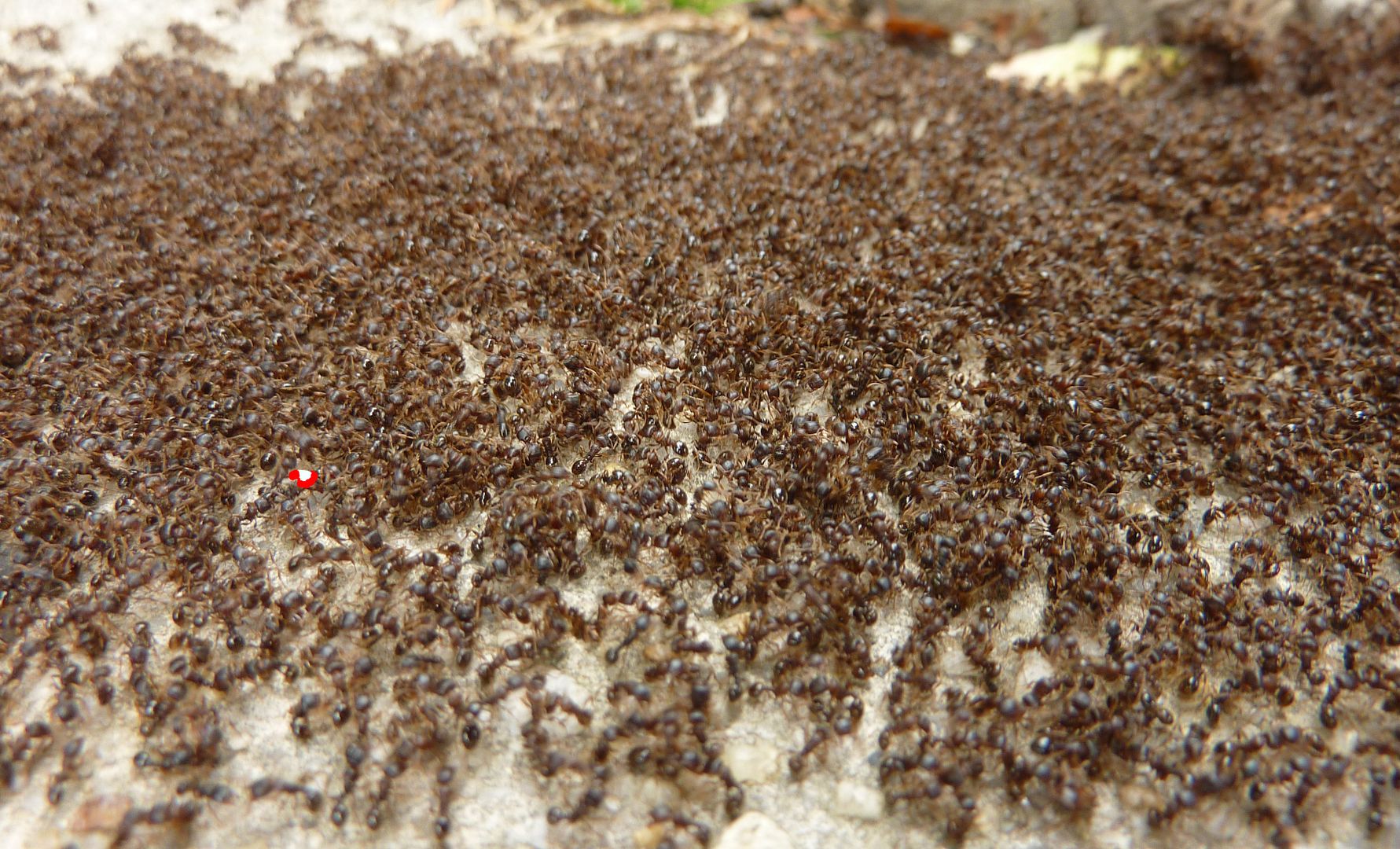 |
| Click to Enlarge |
Wednesday, June 22, 2011
Allium Flowers
Some onions I'd planted last year have decided to flower this summer. It hasn't taken long for the bees to find them.
These are ones meant to be eaten but I'll point out that some Alliums are sold as ornamental. There is a pink flowering variety in particular I've seen sell for $25 a plant. A complete waste of money in my opinion. These normal ones you eat cost about $5 for a pack of about 60. They take a year to flower but frankly people do that with bulbs anyhow.
After flowering you can cut the flower head off or let them go to seed. Harvest after the stem turns brown... I'm not sure if that means the tip, or the whole stalk. I'd assume the more you wait the fatter that bulb will get.
They're also the host plant to something. I've seen this caterpillar on lots of other plants and they seem to change color based on what plant they're on.
These are ones meant to be eaten but I'll point out that some Alliums are sold as ornamental. There is a pink flowering variety in particular I've seen sell for $25 a plant. A complete waste of money in my opinion. These normal ones you eat cost about $5 for a pack of about 60. They take a year to flower but frankly people do that with bulbs anyhow.
After flowering you can cut the flower head off or let them go to seed. Harvest after the stem turns brown... I'm not sure if that means the tip, or the whole stalk. I'd assume the more you wait the fatter that bulb will get.
They're also the host plant to something. I've seen this caterpillar on lots of other plants and they seem to change color based on what plant they're on.
Tuesday, June 21, 2011
I'm High... On Milkweed Flowers
Sorry for no updates in a few weeks. Basically I had half a wisdom tooth removed, (traditionally when removing a tooth they take the whole thing,) so I've been on pain killers that make me a little daffy.
Early on I had a hallucination of women in my living room, nothing sexual mind you. The first one reached over and grabbed the blur tool in photoshop, the tool bar was just floating there next to her apparently, where she kept making herself more and more blurry. There was another women facing away using the brush tool to paint the wall, though her strokes had no effect on the brickwork around our fireplace. The last was using the wand select tool to select things and make the dotted line appear around stuff, including a lamp that we haven't had in our living room in years but there it was. So that was fun.
So I'm finally off my meds, (mostly because the pharmacist is being a dick!) and well enough to operate heavy machinery, and type in complete sentences.
Out in the garden the milkweeds have all started blooming. Asclepias tuberosa, Butterfly Weed, is probably putting off the biggest show. Unfortunately they're mostly the plugs I installed only this year so none of the plants are covered in an abundance of flowers yet. Also none of them are getting any attention from the bees. Older plants send up far more shoots and have more of a small shrub appearance with lots of flower clusters. This time next year should be a dazzling show of flowers.
Despite the common name, Butterfly Weed, I find the only butterflies visiting the flowers are Skippers, Monarchs, Checkerspots, and Fritillaries. Skippers are almost a dime a dozen and I've never seen them in mass over milkweed like they do over some Sedums. Monarchs are mostly interested in it as a host plant and seem to use Milkweeds with larger flowers to nectar from, such as purple or common milkweed. Checkerspots and Fritillaries I've noticed don't seem to travel far from their host plants very often, and thus are only seen on milkweed if there is an established population nearby. I could be wrong on all this but it's just something I've noticed.
What I've been told, is that Asclepias purpurascens, Purple Milkweed, is actually a better plant at attracting butterflies and doesn't get as many bees on it for whatever reason. I want to say it has to do with the size of the flower but I'm not certain on this. At any rate, Purple Milkweed is so pretty it's a wonder why it's not as popular as A. incarnata, Swamp Milkweed. The only thing I could come up with is that Purple Milkweed must be harder to grow in nurseries or else it would be as commonly sold as A. tuberosa. In my opinion Purple Milkweed is equally as pretty as Butterfly Weed and I had hopes to plant the two together for a brilliant color combination. I've 3 plants of it, but only one produced green growth this year, and isn't flowering at all. Hopefully all three come back next year and I can get some flowers going.
Here is Asclepias incarnata, Swamp Milkweed. It's a taller plant, flowers are similar in size to A. tuberosa but clearly a different color. Actually this is a cultivar called 'Cinderella' which differs from the true species in that it lacks the white or paler pink part of the flower in favor of more pink like the rest of the bloom. Thank god for that! I found the candy-cane color of the true species to be very distracting. There is a white flowering cultivar that I didn't like either. 'Cinderella' for whatever reason is marketed as a hummingbird plant, which is the most overused lies growers use to sell plants!
Bees are the primary pollinator of milkweed! I could see a hummingbird maybe using the flower to Asclepias syriaca, Common Milkweed, which are much larger but in that case there wouldn't be any pollination. The bird would be stealing nectar and that doesn't work in my mind for a bird who's beak is designed to fit inside of tube shaped flowers. Milkweed flowers have little groves around them where insect legs are meant to step, there the anther of the flower touches and attaches itself, and the bee walks around with this on her foot until it gets stuck off inside the grove of another milkweed. I don't think hummingbirds even land when feeding.
Early on I had a hallucination of women in my living room, nothing sexual mind you. The first one reached over and grabbed the blur tool in photoshop, the tool bar was just floating there next to her apparently, where she kept making herself more and more blurry. There was another women facing away using the brush tool to paint the wall, though her strokes had no effect on the brickwork around our fireplace. The last was using the wand select tool to select things and make the dotted line appear around stuff, including a lamp that we haven't had in our living room in years but there it was. So that was fun.
So I'm finally off my meds, (mostly because the pharmacist is being a dick!) and well enough to operate heavy machinery, and type in complete sentences.
Out in the garden the milkweeds have all started blooming. Asclepias tuberosa, Butterfly Weed, is probably putting off the biggest show. Unfortunately they're mostly the plugs I installed only this year so none of the plants are covered in an abundance of flowers yet. Also none of them are getting any attention from the bees. Older plants send up far more shoots and have more of a small shrub appearance with lots of flower clusters. This time next year should be a dazzling show of flowers.
Despite the common name, Butterfly Weed, I find the only butterflies visiting the flowers are Skippers, Monarchs, Checkerspots, and Fritillaries. Skippers are almost a dime a dozen and I've never seen them in mass over milkweed like they do over some Sedums. Monarchs are mostly interested in it as a host plant and seem to use Milkweeds with larger flowers to nectar from, such as purple or common milkweed. Checkerspots and Fritillaries I've noticed don't seem to travel far from their host plants very often, and thus are only seen on milkweed if there is an established population nearby. I could be wrong on all this but it's just something I've noticed.
What I've been told, is that Asclepias purpurascens, Purple Milkweed, is actually a better plant at attracting butterflies and doesn't get as many bees on it for whatever reason. I want to say it has to do with the size of the flower but I'm not certain on this. At any rate, Purple Milkweed is so pretty it's a wonder why it's not as popular as A. incarnata, Swamp Milkweed. The only thing I could come up with is that Purple Milkweed must be harder to grow in nurseries or else it would be as commonly sold as A. tuberosa. In my opinion Purple Milkweed is equally as pretty as Butterfly Weed and I had hopes to plant the two together for a brilliant color combination. I've 3 plants of it, but only one produced green growth this year, and isn't flowering at all. Hopefully all three come back next year and I can get some flowers going.
Here is Asclepias incarnata, Swamp Milkweed. It's a taller plant, flowers are similar in size to A. tuberosa but clearly a different color. Actually this is a cultivar called 'Cinderella' which differs from the true species in that it lacks the white or paler pink part of the flower in favor of more pink like the rest of the bloom. Thank god for that! I found the candy-cane color of the true species to be very distracting. There is a white flowering cultivar that I didn't like either. 'Cinderella' for whatever reason is marketed as a hummingbird plant, which is the most overused lies growers use to sell plants!
Bees are the primary pollinator of milkweed! I could see a hummingbird maybe using the flower to Asclepias syriaca, Common Milkweed, which are much larger but in that case there wouldn't be any pollination. The bird would be stealing nectar and that doesn't work in my mind for a bird who's beak is designed to fit inside of tube shaped flowers. Milkweed flowers have little groves around them where insect legs are meant to step, there the anther of the flower touches and attaches itself, and the bee walks around with this on her foot until it gets stuck off inside the grove of another milkweed. I don't think hummingbirds even land when feeding.
Monday, June 13, 2011
Prairie Garden Update: June
So the prairie garden is still establishing itself. Some of the Jacob's Ladder, Milkweed, and Western Spiderwort are already flowering in moderation. Next year these should produce quite an effect with the hot color each of their flowers possesses. I'm not a fan of grasses, least of all the grass that used to be there. Other than laying down mulch I didn't take any time to get rid of the grass, though I did turn the soil before hand. The mulch is making the weeding so much easier. All the desired species stand out and the undesired grass can't lay down any runners.
I've planted everything about 1' apart regardless of size. My logic here is this is how it would be out in a real prairie and the dense foliage will help control anything unwanted from encroaching in. Mowing it each March should help get rid of the bramble.
Species include:
Tall Coreopsis, Coreopsis tripteris. This was for a wow factor, as in wow that coreopsis is 8' tall!
Laceleaf Coreopsis, Coreopsis lanceolata.
Stiff Coreopsis, Coreopsis palmata.
Western Spiderwort, Tradescantia occidentalis. I hear spiderwort is hard to get rid of once established. Considering how pretty the flower is I don't think I'll mind.
Butterfly Weed, Asclepias tuberosa. How dare any gardener in North America have a shortage of this plant in their garden! If I can find a nursery selling Purple Milkweed, Asclepias purpurascens, in abundance I should plant these two species together in mass.
Showy Goldenrod, Solidago speciosa. A bit of a thug from my understanding, really I planted this just to round out the number of Solidago species I have in the yard. The brilliant yellow flowers go great with any species of Aster.
Blue Star, Amsonia ciliata. Unlike other Amsonia species these have slightly bigger flowers. A downside though is that they get considerably bigger than I originally though. I saw one at a nursery and the thing was a fair sized bush. So I may divide or transplant this out eventually, but I'm glad I finally got some of these going in the garden.
Blue False Indigo, Baptisia australis. This is another plant that gets to big for it's own good. The flowers and seed pods are decorative. These will stick up above shorter species and add some height to the corners.
Purple Prairie Clover, Dalea purpurea. These plants balance their own nitrogen and should overall benefit the garden. I was sure to spread them out, which was easy as they're fairly compact little things.
Jacob's Ladder, Polemonium reptans. I was at a nursery earlier today and saw they were selling 3 cultivars of this plant but somehow failed to stock the true species. It seems as though plants have to have damaged leaf color, or triple flowers
Ozark Coneflower, Echinacea paradoxa. For whatever reason there are cultivars of other coneflowers that are yellow, which begs the question why people aren't just planting the yellow species of coneflower.
Orange Coneflower, Rudbeckia fulgida. This is a coneflower that almost mimics a Black Eye'd Susan. I've never grown it before so this should be interesting.
Meadow Liatris, Liatris ligulistylis. I should have probably tried out some more indigenous species of Liatris but I've always had success with these and Monarchs.
Aromatic Aster, Symphyotrichum oblongifolium.
Sky Blue Aster, Symphyotrichum oolentangiense (formerly Aster azureus).
Smooth Blue Aster, Symphyotrichum laeve.
All of these Asters have a variety of blues and lavender colors that should really brighten up the garden come fall.
So I'm hoping a lot of these plants survive the winter. One can never be certain. Replacement plantings will depend on what died and where it was in the prairie.
I've planted everything about 1' apart regardless of size. My logic here is this is how it would be out in a real prairie and the dense foliage will help control anything unwanted from encroaching in. Mowing it each March should help get rid of the bramble.
Species include:
Tall Coreopsis, Coreopsis tripteris. This was for a wow factor, as in wow that coreopsis is 8' tall!
Laceleaf Coreopsis, Coreopsis lanceolata.
Stiff Coreopsis, Coreopsis palmata.
Western Spiderwort, Tradescantia occidentalis. I hear spiderwort is hard to get rid of once established. Considering how pretty the flower is I don't think I'll mind.
Butterfly Weed, Asclepias tuberosa. How dare any gardener in North America have a shortage of this plant in their garden! If I can find a nursery selling Purple Milkweed, Asclepias purpurascens, in abundance I should plant these two species together in mass.
Showy Goldenrod, Solidago speciosa. A bit of a thug from my understanding, really I planted this just to round out the number of Solidago species I have in the yard. The brilliant yellow flowers go great with any species of Aster.
Blue Star, Amsonia ciliata. Unlike other Amsonia species these have slightly bigger flowers. A downside though is that they get considerably bigger than I originally though. I saw one at a nursery and the thing was a fair sized bush. So I may divide or transplant this out eventually, but I'm glad I finally got some of these going in the garden.
Blue False Indigo, Baptisia australis. This is another plant that gets to big for it's own good. The flowers and seed pods are decorative. These will stick up above shorter species and add some height to the corners.
Purple Prairie Clover, Dalea purpurea. These plants balance their own nitrogen and should overall benefit the garden. I was sure to spread them out, which was easy as they're fairly compact little things.
Jacob's Ladder, Polemonium reptans. I was at a nursery earlier today and saw they were selling 3 cultivars of this plant but somehow failed to stock the true species. It seems as though plants have to have damaged leaf color, or triple flowers
Ozark Coneflower, Echinacea paradoxa. For whatever reason there are cultivars of other coneflowers that are yellow, which begs the question why people aren't just planting the yellow species of coneflower.
Orange Coneflower, Rudbeckia fulgida. This is a coneflower that almost mimics a Black Eye'd Susan. I've never grown it before so this should be interesting.
Meadow Liatris, Liatris ligulistylis. I should have probably tried out some more indigenous species of Liatris but I've always had success with these and Monarchs.
Aromatic Aster, Symphyotrichum oblongifolium.
Sky Blue Aster, Symphyotrichum oolentangiense (formerly Aster azureus).
Smooth Blue Aster, Symphyotrichum laeve.
All of these Asters have a variety of blues and lavender colors that should really brighten up the garden come fall.
So I'm hoping a lot of these plants survive the winter. One can never be certain. Replacement plantings will depend on what died and where it was in the prairie.
Sunday, June 12, 2011
Native Plants Honeybees Love (part 2 of 2)
This is a continuation of the former list. I don't personally grow these, and many I've never seen in person but I hear good things.
More Native Plants Bees Might Love
Culver's Root, Veronicastrum virginicum. I'll eventually be adding this to my garden at some point. The google image search looks promising, but I see way more bumblebees than honeybees. Not that that's a bad thing it would just be nice to increase honey yields along with helping out nature.
Assuming Culver's Root is a hit with honeybees then maybe other natives with similar flower shapes would also work. For example, Lead Plant, Amorpha canescens, and relatives. These are more colorful looking, and one species around me is actually a tree. I have one or two of the herbaceous perennial species growing in dry partial shade but they have yet to produce flowers for the two year's I've had them. Considering what a nice color combination the flowers are I'm really hoping these work out. These are long lived perennials with a woody sage-like form.
American Burnet, Sanguisorba canadensis, is another one I hope to add to the garden. It's by no means a very common plant, but Prairie Moon Nursery praises it and offers pictures of honeybees working this plant, and that's good enough for me to recommend it. I've seen it in person and was frankly underwhelmed.
Buttonbush, Cephalanthus occidentalis. To this day my jaw still drops at how no one grows this plant. It's basically our native version of a Butterfly Bush, who's seeds are eaten by birds, and gets every bit of butterfly attention. The flowers are lightly scented. They can grow in up to 4' of water but tolerate growing in normal garden soil just fine. As with Joe Pye Weed, these get assorted bees and butterflies. Why isn't this grown in more nurseries? It seems to be it's just a matter of the public not knowing about the plant. My heart skipped a beat when I saw them on sale at Popes' Gardens here in NJ because I've always had to special order this plant. I made the owner thrilled with I bought one from her as she said they rarely sell any of their stock. I'm so happy with the first one I may go back and buy another this year. She said they almost always sell out of butterfly bushes but rarely does anyone ask for a buttonbush.
Sensitive Brier, Schrankia sp. Okay for this play you'll need to do a google image search so everyone knows what I'm talking about. These used to be in the genus Mimosa, however they were put in their own genus I believe because they're all thorn covered vines that get 5' long at most. The flowers are amazingly showy, especially considering there isn't a garden center in the country that sells the thing. How did this amazing little puff ball escape the eyes of the horticultural industry? Granted it's covered in thorns, but you're almost encouraged to touch the plant as the leaves will actually move in response! Honeybees love them all too, I've seen pictures of these plants covered in them.
Prickly Pear, Opuntia sp. I know a number of beekeepers who have these on their property. Even here in NJ there are indigenous cacti. Opuntia humifusa is our native species but there are lots of these scattered about the country. See USDA. Each year they produce several massive flowers. In nature they typically form a sort of ground cover around a pine tree here in the Pine Barrens. Despite having needles as a defense, they don't hold up to foot traffic, though it's discouraged.
Corn is another great plant for honeybees. Officially Corn is wind pollinated and needs no bee activity to produce a crop. The pollen anthers are so robust with pollen though that bees simply can't resist stocking up on it. Pollen is fed directly to brood and only effects honey yields in the secondary effect of producing more bees. Some sunflowers have this effect as well but I'd say neither are really important.
Spring Ephemerals?
For those of you reading my blog and perhaps others like it, you may have noted that there's an abundance of spring ephemerals that all bloom early in the year. As mentioned in part 1, there's to much blooming up in the tree line to get honeybee attention. There is of course the occasional scout or forager who's found something good but not good enough to tell the others. Despite the abundance of spring time flowers honeybees really don't go for spring ephemerals. Perhaps there is a flaw with the waggle dance. They can tell other bees where the sun is, how many degrees to the left or right, and even how far they should fly but what they can't tell them is the height. Honeybees typically take off from the nest and reach a flying altitude of about 30' off the ground, maybe higher. This puts them at eye level with the trees!
Another reason is that many spring ephemerals really don't want bees pollinating them.
May Apples have big umbrella like leaves that create a thick canapé, blocking out sight of the forest above. This also traps humidity and encourages insect activity down below. Their flowers are hidden down and out of sight where few bees are likely to venture. Beetles are the pollinator of choice as they emerge from the leaf litter these big flowers are pretty much all they can see.
Others such as Trilliums look more promising as at least a few of those species hold their flower high and proud. Even so, a lot will still produce a fowl odor to attract flies and beetles to their flowers over bees. I've seen honeybees visit Trillium grandiflorum but it seemed more of a flook day to me.
Those that want honeybee attention are more likely to have lots of flowers. So anything monofloral is out. The logic here is that a lot of monofloral plants are simply producing a flower as option 2 to their reproduction. Often a Trillium will spread more readily by expanding it's rhizome and produce more shoots next year. The result is a clump of the same plant slowly dividing underground. When pollination does occur often the seeds are transplanted by ants elsewhere to start a new clump.
Jacob's Ladder, Polemonium caeruleum, I'm told might be a noteworthy plant. If true, this might be my new favorite plant to put everywhere. They are drought tolerant, grow in full sun, to full shade, and have an almost fern-like appearance which most people will appreciate. I have a few of these in my prairie garden, the idea being they'd come up and flower in the spring and hopefully not mind getting shaded out some by everything else as summer rolls in. I bought the straight species which has nice forest green foliage, and who's flowers start out white then turn a lavender-blue color before fading. There are a number of cultivars of this plant available.
Phacilia is another note worthy option. Locally these are sold in seed packets as annuals but there are a number of perennial species too. P. bipinnatifida is one I'd like to try but I haven't found anyone selling it as of yet.
Food Crops
Not a native plant buff? Good news! Just about every food crop or herb in the common garden will flower and get the attention of bees. And the pest part is, Tomatoes, some Blackberries, Raspberries, and Strawberries all have native counterparts. Sadly there are so many cultivars, varieties, and hybrids floating around that caring about what the species is almost impractical. Assuming you're growing these as a food source though, I don't think it should matter as much. That said some of these food crops and herbs are sketchy in my mind.
Borage. This is a plant I recommend to anyone who says annuals are a waste of money. This plant is flowering by week 6 and seeding by week 8 after germination. These seeds germinate 2 weeks later and continue prolifically to flower and set seed well into the winter, where seedlings go dormant until next spring! Bees love the flowers, but calling this plant a crop is questionable. You can eat the flowers but what's the point of growing it then? You can eat the tender new growth as a salad green but the entire plant is covered in spiky hairs. Proper boiling and blanching is required.
Broccoli and other Salad Greens are pollinated by Honeybees and lots of other things for that matter. So these are good but growing these plants for the flowers isn't the point of the crop. Maybe just let a few bolt, as it's called, and collect some seed.
Thyme, Basil, Rosmary and Sage Just about every other herb there is, are excellent for hoenybees.
Lavender is one of the best in my opinion, however it rarely grows this well here in the US. I believe adding sand to the soil helps out with this. Mulching can help too but really I've never tied this in person.
I could probably talk more on this at a later date but for the most part those are all the plants I can recommend off the top of my head. Hope these help someone out there.
More Native Plants Bees Might Love
Culver's Root, Veronicastrum virginicum. I'll eventually be adding this to my garden at some point. The google image search looks promising, but I see way more bumblebees than honeybees. Not that that's a bad thing it would just be nice to increase honey yields along with helping out nature.
Assuming Culver's Root is a hit with honeybees then maybe other natives with similar flower shapes would also work. For example, Lead Plant, Amorpha canescens, and relatives. These are more colorful looking, and one species around me is actually a tree. I have one or two of the herbaceous perennial species growing in dry partial shade but they have yet to produce flowers for the two year's I've had them. Considering what a nice color combination the flowers are I'm really hoping these work out. These are long lived perennials with a woody sage-like form.
American Burnet, Sanguisorba canadensis, is another one I hope to add to the garden. It's by no means a very common plant, but Prairie Moon Nursery praises it and offers pictures of honeybees working this plant, and that's good enough for me to recommend it. I've seen it in person and was frankly underwhelmed.
Buttonbush, Cephalanthus occidentalis. To this day my jaw still drops at how no one grows this plant. It's basically our native version of a Butterfly Bush, who's seeds are eaten by birds, and gets every bit of butterfly attention. The flowers are lightly scented. They can grow in up to 4' of water but tolerate growing in normal garden soil just fine. As with Joe Pye Weed, these get assorted bees and butterflies. Why isn't this grown in more nurseries? It seems to be it's just a matter of the public not knowing about the plant. My heart skipped a beat when I saw them on sale at Popes' Gardens here in NJ because I've always had to special order this plant. I made the owner thrilled with I bought one from her as she said they rarely sell any of their stock. I'm so happy with the first one I may go back and buy another this year. She said they almost always sell out of butterfly bushes but rarely does anyone ask for a buttonbush.
Sensitive Brier, Schrankia sp. Okay for this play you'll need to do a google image search so everyone knows what I'm talking about. These used to be in the genus Mimosa, however they were put in their own genus I believe because they're all thorn covered vines that get 5' long at most. The flowers are amazingly showy, especially considering there isn't a garden center in the country that sells the thing. How did this amazing little puff ball escape the eyes of the horticultural industry? Granted it's covered in thorns, but you're almost encouraged to touch the plant as the leaves will actually move in response! Honeybees love them all too, I've seen pictures of these plants covered in them.
Prickly Pear, Opuntia sp. I know a number of beekeepers who have these on their property. Even here in NJ there are indigenous cacti. Opuntia humifusa is our native species but there are lots of these scattered about the country. See USDA. Each year they produce several massive flowers. In nature they typically form a sort of ground cover around a pine tree here in the Pine Barrens. Despite having needles as a defense, they don't hold up to foot traffic, though it's discouraged.
Corn is another great plant for honeybees. Officially Corn is wind pollinated and needs no bee activity to produce a crop. The pollen anthers are so robust with pollen though that bees simply can't resist stocking up on it. Pollen is fed directly to brood and only effects honey yields in the secondary effect of producing more bees. Some sunflowers have this effect as well but I'd say neither are really important.
Spring Ephemerals?
For those of you reading my blog and perhaps others like it, you may have noted that there's an abundance of spring ephemerals that all bloom early in the year. As mentioned in part 1, there's to much blooming up in the tree line to get honeybee attention. There is of course the occasional scout or forager who's found something good but not good enough to tell the others. Despite the abundance of spring time flowers honeybees really don't go for spring ephemerals. Perhaps there is a flaw with the waggle dance. They can tell other bees where the sun is, how many degrees to the left or right, and even how far they should fly but what they can't tell them is the height. Honeybees typically take off from the nest and reach a flying altitude of about 30' off the ground, maybe higher. This puts them at eye level with the trees!
Another reason is that many spring ephemerals really don't want bees pollinating them.
May Apples have big umbrella like leaves that create a thick canapé, blocking out sight of the forest above. This also traps humidity and encourages insect activity down below. Their flowers are hidden down and out of sight where few bees are likely to venture. Beetles are the pollinator of choice as they emerge from the leaf litter these big flowers are pretty much all they can see.
Others such as Trilliums look more promising as at least a few of those species hold their flower high and proud. Even so, a lot will still produce a fowl odor to attract flies and beetles to their flowers over bees. I've seen honeybees visit Trillium grandiflorum but it seemed more of a flook day to me.
Those that want honeybee attention are more likely to have lots of flowers. So anything monofloral is out. The logic here is that a lot of monofloral plants are simply producing a flower as option 2 to their reproduction. Often a Trillium will spread more readily by expanding it's rhizome and produce more shoots next year. The result is a clump of the same plant slowly dividing underground. When pollination does occur often the seeds are transplanted by ants elsewhere to start a new clump.
Jacob's Ladder, Polemonium caeruleum, I'm told might be a noteworthy plant. If true, this might be my new favorite plant to put everywhere. They are drought tolerant, grow in full sun, to full shade, and have an almost fern-like appearance which most people will appreciate. I have a few of these in my prairie garden, the idea being they'd come up and flower in the spring and hopefully not mind getting shaded out some by everything else as summer rolls in. I bought the straight species which has nice forest green foliage, and who's flowers start out white then turn a lavender-blue color before fading. There are a number of cultivars of this plant available.
Phacilia is another note worthy option. Locally these are sold in seed packets as annuals but there are a number of perennial species too. P. bipinnatifida is one I'd like to try but I haven't found anyone selling it as of yet.
Food Crops
Not a native plant buff? Good news! Just about every food crop or herb in the common garden will flower and get the attention of bees. And the pest part is, Tomatoes, some Blackberries, Raspberries, and Strawberries all have native counterparts. Sadly there are so many cultivars, varieties, and hybrids floating around that caring about what the species is almost impractical. Assuming you're growing these as a food source though, I don't think it should matter as much. That said some of these food crops and herbs are sketchy in my mind.
Borage. This is a plant I recommend to anyone who says annuals are a waste of money. This plant is flowering by week 6 and seeding by week 8 after germination. These seeds germinate 2 weeks later and continue prolifically to flower and set seed well into the winter, where seedlings go dormant until next spring! Bees love the flowers, but calling this plant a crop is questionable. You can eat the flowers but what's the point of growing it then? You can eat the tender new growth as a salad green but the entire plant is covered in spiky hairs. Proper boiling and blanching is required.
Broccoli and other Salad Greens are pollinated by Honeybees and lots of other things for that matter. So these are good but growing these plants for the flowers isn't the point of the crop. Maybe just let a few bolt, as it's called, and collect some seed.
Thyme, Basil, Rosmary and Sage Just about every other herb there is, are excellent for hoenybees.
Lavender is one of the best in my opinion, however it rarely grows this well here in the US. I believe adding sand to the soil helps out with this. Mulching can help too but really I've never tied this in person.
I could probably talk more on this at a later date but for the most part those are all the plants I can recommend off the top of my head. Hope these help someone out there.
Monday, June 6, 2011
Native Plants Honeybees Love (part 1 of 2)
We are nearing the end of Swarm Season for honeybees. There are the occasional swarms over the summer months and even rarely in autumn, but spring time seems to be the peak. There are two main reasons for this.
The first, is that it takes 21 days for a worker bee to be born. Honeybees don't take any of the old nest with them, but rather have to build new comb wherever they decide to settle down. That's 21 days where the population is getting lower and lower. So the sooner swarming can occur the sooner they can start becoming productive. The saying around here is "swarm after July, let it fly." This is true enough, but of course all they really need is lots of help. Boosting with frames of brood or already drawn frames of comb, as well as maybe extra feeding, should help any hive along.
The second reason is likely the ever prevalent sources of nectar available to the bees. As early as February all the trees start blooming here. Willows, Maples, Hazelnut, quickly turn into Dogwood, Redbud, Poplar, Oak, Magnolia, Cherry, Basswood/Linden, Birch, and assorted Fruit Trees, such as Apple, Plum, Pear, Peach and so on. Before the end of spring, Honey Locust Trees, and White Dutch Clover will bloom, which are two of the most abundant sources of nectar locally here in NJ.
The abundance of food available makes spring time the easiest for bee swarms. Even before they've found a place to live, hanging swarms send out foragers.
Here Chip Taylor (Chuck?) over at Monarch Watch has caught a swarm using a chemical swarm lore.
I often hear beekeepers proclaim that they're hives are good for the environment. In truth, Apis millifera, is a nonnative species that was imported to aid with mono-cultural farming. Their native range is most of Africa, Europe, and about the western third of Asia. A food crop in their own right, Honeybees have become something of a backyard hobby for community gardens, people with to much land, and even city residents.
So their nectar needs are pretty much filled in the spring time. This leaves people wondering what bees work, or more precisely, what they can plant to help their honey yields.
Asking your local beekeeping association and they'll likely recommend: Purple Loosestrife, Japanese Knotweed, Kudzu, Catmint, Chinese Popcorn Trees. Generally the more of a noxious weed and invasive it is the more honeybees love it. Ask anyone who is environmentally conscious and they'll tell you NOT to plant any of these!
Why Do Honeybees Love Invasive Plants?
This has to do with the way Honeybees communicate to one another.
Minus a strange comment about "if the bee doesn't stop dancing immediately she will be stung to death" this is fairly accurate.
So we have an entire society of around 60,000 bees with many of them acting as foragers. As they find abundant sources of food up to 6 miles away from the hive, they have to return and tell the other foragers what and where they found. Invasive plants tend to take over or be very abundant where they occur. So naturally when they discover such a food source they take full advantage of it, passing over other, less abundant sources in the process. In essence they get distracted. As mentioned before they are used to pollinate farms which are typically monoculars. Despite blueberry plants having flowers that honeybees have trouble with, the bees still manage to persevere and pollinate the plants. In fact honeybees love just about everything that flowers in a vegetable and herb garden.
Understanding these habits is the key to getting honeybees into your garden.
Native Plants Honeybees Love
When planting for Honeybees the 3 to 5 plant rule most certainly applies, more would be better! But all flowers are not created equally.
Here we have a Thalictrum species, Meadow Rue, which is probably not a native. Other than having it's pollen anthers out for all to see, these flowers have nothing going for them. If I had massive basket ball sized clumps of these flowers out in the garden then yes I might see a few bees on them. This plant is mostly pollinated by flies, and flies that mimic bees oddly enough.
It's best to go with members of the composite family.
A sunflower is an excellent example of what a composite flower is. The outer most ring here is comprised of fake flower petals. The ring with the bee on it is comprised of all the flowers that are in bloom, each of those black anthers is poking out of its own flower. With sunflowers and most composites the flowers bloom from the outside and work their way in, so the inner most ring here are flowers that have yet to open. Often though people think of a sunflower as being one giant flower.
Sunflowers are also the plant of choice for Goldfinches, short of a field of Coneflowers which can be hard to establish.
Honeybees go to them too, but that late in the year typically their attention is elsewhere. Also notice how each of these purple clusters is comprised of multiple flowers as with the sunflower.
Butterfly Weed, Asclepias tuberosa, is a host plant for the Monarch Butterfly as well as 11, or so, other Lepidoptera. It's also host so several beetles for assorted reasons, food and mating to name a few.
Milkweeds, Asclepias sp. get misunderstood with a lot of beekeepers. Basically the anthers get attached to the bee’s legs and can leave them hanging from the flowers. The misconception is that the bee dies from exhaustion. This isn’t true though. They eventually get free and the anthers are later removed. Assassin bugs, however, will take advantage of a few bees that get stuck. So beekeepers shouldn’t be put off from including these plants in their pollinator garden. It doesn’t happen as often as it sounds. A. tuberose, A. purpurascens, and A. incarnate are excellent garden choices.
Stokes Aster, Stokesia laevis, is a good choice for slightly acidic soil.
Gaillardia aristata, Blanket Flower, normally has a red, orange and yellow flower. Whatever color your's may have it doesn't matter to the honey bees.
Coneflower, Echinacea, is good but should really be mass planted. They're occasionally nibbled upon by Goldfinches when they go to seed, but you really need like 20 plants to see that happening consistently. I have a theory that it's best to grow this plant from seed when you can. Store bought cultivars don't seem to reproduce but will work in the mean time as long as they're not double flowering.
Dalea purpurea, Purple Prairie Clover. There is also a White Prairie Clover that I imagen gets the same amount of attention. I think this is a clump of several plants in this video as I've never known them to get that tall or big.
Spiderwort, Tradescantia sp. I think it's best to have several 3 gallon sized plants in order to get their attention. The flowers are also only open in the day time but that's not a bad thing. A lot of plants might even stop producing nectar by around 4:00pm.
Anis Hyssop, Agastache foeniculum.
Cup Plant, Silphium perfoliatum, is a little aggressive and seedlings can be downright weedy, but this is a good plant when kept under control. Each plant forms its own patch and thankfully seems to peter out from there. The leaves come together to form a small cup that collects water, hence the common name. Bees not only love the flowers but go for the water in the cups as well. They are fairly straight up and don't fall over often. It’s a surprisingly good butterfly plant too.
Rhus copallinum, Winged Sumac. Probably other Sumacs as well. This one wants to form it's own grove and sends up root suckers. They're common to see along road sides.
St. Johnswort, Hypericum sp. has wonderful puffy yellow flowers that produce rich amounts of pollen bees can’t resist. H. punctatum and H. pyramidatum are herbaceous perennials. H. prolificumis a deciduous shrub that gets to be about 4’ by 5’in diameter. Be afraid of H. perforatum,which is an imported noxious weed!
Most Eupatorium species are great for honeybees. In this case E. fistulosum which gets pretty big, but there are also smaller species as well. They like being around water and often droop in the afternoon sun. As the shade hits them they perk right back up and when flowering usually produce a medicinal-like odor at that time of day.
Eupatorium coelestinum, Blue Mist Flower, is a smaller species that blooms towards the end of summer. I haven't had it for very long but I've found honeybees enjoy it. I've read however that it's a tad aggressive.
Clether alnifolia, Summer Sweet is also very shade tolerant but will grow in full sun nicely too. The flowers can be extremely fragrant when they want to be. The other common name for this plant is Sailor's Delight because on someday you could smell it out at sea. I haven’t quite figured it out yet, but occasionally I can smell my neighbor’s plant from 30’ away and it's covered in a cloud bee. More commonly though the fragrance rarely travels more than 5 feet and the bee numbers are not what they were but still great.
As we move into fall Asters become a main source of nectar. Something to note though is that Aster was recently divided into 7 genera, that are all now Asters in common name only. The genus Symphyotrichum is the main one you want to pay attention to I've found, S. novi-belgii, New York Aster, is one I like but can't seem to come back year after year.
Symphyotrichum novae-angliae, New England Aster, is one I have better luck with. An issue though is they get nice and tall but by autumn all the lower growth has died off the plant and the dam things want to fall over.
These are a favorite for Monarchs as well as Bees.
Aster oblongifolius is one I'm trying this year. It blooms in November, very late in the year! But it has a natural domed habit so no falling over.
Goldenrods are the second big plant now, if not the biggest plant! Beekeepers are on the fence with these as they're great nectar sources, but also make a honeybee hive smell like a gym sock, which the bees don't mind. The honey tastes good, but has a tangy fragrance. Typically the bees will have eaten these stores over the winter if left alone.
The other thing about goldenrods is the majority of species are aggressive. Often they'll spread by root suckers. People who restore and maintain prairies for a living often shun Canadian Goldenrod for this reason. And honestly there's enough of it colonizing roadsides and areas around major power lines that it's not essential to anyone's garden. Still though I've added a few good choices that are at least easy to control.
Solidago sphacelata, Autumn Goldenrod, is a showy low growing perennial that almost creeps along the ground. Perfect for a garden boarder.
Solidago rugosa, in this case you're looking at it's cultivar 'Fireworks' which has nicely spread out long stringy looking flowers. The true species has thicker flower clusters that are most focused higher up on the plant. This species will spread a little by seed and root sucker but not on the same scale as other Goldenrods.
As a general rule, typically the shorter Solidago species bloom earlier in the year, while the taller ones bloom much later.
Solidago altissima, Tall Goldenrod, is NOT one I recommend for the garden. I have it in my own garden but only because it blooms in October through November when almost nothing else is in flower. Naturally it gets covered in bees and I even see queen bumblebees working it in preparation for next year.
This plant started as just one cane coming from the ground. Year two that turned into about 7, and it's been sending up 7 to 12 more canes every year now. Despite being aggressive though I've found the root suckers are simple to weed. Cutting them off at the tip causes them to grow out from the sides of where you just cut, so you can sort of herd it to grow like a box and pull up what you don't need.
Another honorable mention should go to Vernonia sp., Ironweed, which I don't have a picture of so here's a google image search. They're also a hit with butterflies as well as bees.
Thistle is also good for bees but sadly I've found all species to be aggressive spreading, covered in thorns, and the very definition of what a weed is.
The first, is that it takes 21 days for a worker bee to be born. Honeybees don't take any of the old nest with them, but rather have to build new comb wherever they decide to settle down. That's 21 days where the population is getting lower and lower. So the sooner swarming can occur the sooner they can start becoming productive. The saying around here is "swarm after July, let it fly." This is true enough, but of course all they really need is lots of help. Boosting with frames of brood or already drawn frames of comb, as well as maybe extra feeding, should help any hive along.
The second reason is likely the ever prevalent sources of nectar available to the bees. As early as February all the trees start blooming here. Willows, Maples, Hazelnut, quickly turn into Dogwood, Redbud, Poplar, Oak, Magnolia, Cherry, Basswood/Linden, Birch, and assorted Fruit Trees, such as Apple, Plum, Pear, Peach and so on. Before the end of spring, Honey Locust Trees, and White Dutch Clover will bloom, which are two of the most abundant sources of nectar locally here in NJ.
The abundance of food available makes spring time the easiest for bee swarms. Even before they've found a place to live, hanging swarms send out foragers.
Here Chip Taylor (Chuck?) over at Monarch Watch has caught a swarm using a chemical swarm lore.
I often hear beekeepers proclaim that they're hives are good for the environment. In truth, Apis millifera, is a nonnative species that was imported to aid with mono-cultural farming. Their native range is most of Africa, Europe, and about the western third of Asia. A food crop in their own right, Honeybees have become something of a backyard hobby for community gardens, people with to much land, and even city residents.
So their nectar needs are pretty much filled in the spring time. This leaves people wondering what bees work, or more precisely, what they can plant to help their honey yields.
Asking your local beekeeping association and they'll likely recommend: Purple Loosestrife, Japanese Knotweed, Kudzu, Catmint, Chinese Popcorn Trees. Generally the more of a noxious weed and invasive it is the more honeybees love it. Ask anyone who is environmentally conscious and they'll tell you NOT to plant any of these!
Why Do Honeybees Love Invasive Plants?
This has to do with the way Honeybees communicate to one another.
Minus a strange comment about "if the bee doesn't stop dancing immediately she will be stung to death" this is fairly accurate.
So we have an entire society of around 60,000 bees with many of them acting as foragers. As they find abundant sources of food up to 6 miles away from the hive, they have to return and tell the other foragers what and where they found. Invasive plants tend to take over or be very abundant where they occur. So naturally when they discover such a food source they take full advantage of it, passing over other, less abundant sources in the process. In essence they get distracted. As mentioned before they are used to pollinate farms which are typically monoculars. Despite blueberry plants having flowers that honeybees have trouble with, the bees still manage to persevere and pollinate the plants. In fact honeybees love just about everything that flowers in a vegetable and herb garden.
Understanding these habits is the key to getting honeybees into your garden.
Native Plants Honeybees Love
When planting for Honeybees the 3 to 5 plant rule most certainly applies, more would be better! But all flowers are not created equally.
Here we have a Thalictrum species, Meadow Rue, which is probably not a native. Other than having it's pollen anthers out for all to see, these flowers have nothing going for them. If I had massive basket ball sized clumps of these flowers out in the garden then yes I might see a few bees on them. This plant is mostly pollinated by flies, and flies that mimic bees oddly enough.
It's best to go with members of the composite family.
A sunflower is an excellent example of what a composite flower is. The outer most ring here is comprised of fake flower petals. The ring with the bee on it is comprised of all the flowers that are in bloom, each of those black anthers is poking out of its own flower. With sunflowers and most composites the flowers bloom from the outside and work their way in, so the inner most ring here are flowers that have yet to open. Often though people think of a sunflower as being one giant flower.
Sunflowers are also the plant of choice for Goldfinches, short of a field of Coneflowers which can be hard to establish.
Liatris, Shooting Star, is a great option. Don't restrict yourself to the mass marketed one sold by the bag in garden centers though. There's nothing wrong with that species but it only flowers in June.
Much taller and later flowering species such as Liatris ligulistylis, are a magnet for Monarch butterflies.
Honeybees go to them too, but that late in the year typically their attention is elsewhere. Also notice how each of these purple clusters is comprised of multiple flowers as with the sunflower.
Butterfly Weed, Asclepias tuberosa, is a host plant for the Monarch Butterfly as well as 11, or so, other Lepidoptera. It's also host so several beetles for assorted reasons, food and mating to name a few.
Milkweeds, Asclepias sp. get misunderstood with a lot of beekeepers. Basically the anthers get attached to the bee’s legs and can leave them hanging from the flowers. The misconception is that the bee dies from exhaustion. This isn’t true though. They eventually get free and the anthers are later removed. Assassin bugs, however, will take advantage of a few bees that get stuck. So beekeepers shouldn’t be put off from including these plants in their pollinator garden. It doesn’t happen as often as it sounds. A. tuberose, A. purpurascens, and A. incarnate are excellent garden choices.
Stokes Aster, Stokesia laevis, is a good choice for slightly acidic soil.
Gaillardia aristata, Blanket Flower, normally has a red, orange and yellow flower. Whatever color your's may have it doesn't matter to the honey bees.
Coneflower, Echinacea, is good but should really be mass planted. They're occasionally nibbled upon by Goldfinches when they go to seed, but you really need like 20 plants to see that happening consistently. I have a theory that it's best to grow this plant from seed when you can. Store bought cultivars don't seem to reproduce but will work in the mean time as long as they're not double flowering.
Dalea purpurea, Purple Prairie Clover. There is also a White Prairie Clover that I imagen gets the same amount of attention. I think this is a clump of several plants in this video as I've never known them to get that tall or big.
Spiderwort, Tradescantia sp. I think it's best to have several 3 gallon sized plants in order to get their attention. The flowers are also only open in the day time but that's not a bad thing. A lot of plants might even stop producing nectar by around 4:00pm.
Tick Seed, Coreopsis sp. Ones that reproduce slowly by seed are best, not only for free plant, but they help compete with grass that is otherwise taking up space.
Rudbeckia sp. These are hit or miss. Some years I see bees going nuts over the Black-Eyed Susans and on other years they could care less.
Anis Hyssop, Agastache foeniculum.
St. Johnswort, Hypericum sp. has wonderful puffy yellow flowers that produce rich amounts of pollen bees can’t resist. H. punctatum and H. pyramidatum are herbaceous perennials. H. prolificumis a deciduous shrub that gets to be about 4’ by 5’in diameter. Be afraid of H. perforatum,which is an imported noxious weed!
Most Eupatorium species are great for honeybees. In this case E. fistulosum which gets pretty big, but there are also smaller species as well. They like being around water and often droop in the afternoon sun. As the shade hits them they perk right back up and when flowering usually produce a medicinal-like odor at that time of day.
Eupatorium coelestinum, Blue Mist Flower, is a smaller species that blooms towards the end of summer. I haven't had it for very long but I've found honeybees enjoy it. I've read however that it's a tad aggressive.
Clether alnifolia, Summer Sweet is also very shade tolerant but will grow in full sun nicely too. The flowers can be extremely fragrant when they want to be. The other common name for this plant is Sailor's Delight because on someday you could smell it out at sea. I haven’t quite figured it out yet, but occasionally I can smell my neighbor’s plant from 30’ away and it's covered in a cloud bee. More commonly though the fragrance rarely travels more than 5 feet and the bee numbers are not what they were but still great.
As we move into fall Asters become a main source of nectar. Something to note though is that Aster was recently divided into 7 genera, that are all now Asters in common name only. The genus Symphyotrichum is the main one you want to pay attention to I've found, S. novi-belgii, New York Aster, is one I like but can't seem to come back year after year.
Symphyotrichum novae-angliae, New England Aster, is one I have better luck with. An issue though is they get nice and tall but by autumn all the lower growth has died off the plant and the dam things want to fall over.
These are a favorite for Monarchs as well as Bees.
Aster oblongifolius is one I'm trying this year. It blooms in November, very late in the year! But it has a natural domed habit so no falling over.
Goldenrods are the second big plant now, if not the biggest plant! Beekeepers are on the fence with these as they're great nectar sources, but also make a honeybee hive smell like a gym sock, which the bees don't mind. The honey tastes good, but has a tangy fragrance. Typically the bees will have eaten these stores over the winter if left alone.
The other thing about goldenrods is the majority of species are aggressive. Often they'll spread by root suckers. People who restore and maintain prairies for a living often shun Canadian Goldenrod for this reason. And honestly there's enough of it colonizing roadsides and areas around major power lines that it's not essential to anyone's garden. Still though I've added a few good choices that are at least easy to control.
Solidago sphacelata, Autumn Goldenrod, is a showy low growing perennial that almost creeps along the ground. Perfect for a garden boarder.
Solidago rugosa, in this case you're looking at it's cultivar 'Fireworks' which has nicely spread out long stringy looking flowers. The true species has thicker flower clusters that are most focused higher up on the plant. This species will spread a little by seed and root sucker but not on the same scale as other Goldenrods.
As a general rule, typically the shorter Solidago species bloom earlier in the year, while the taller ones bloom much later.
Solidago altissima, Tall Goldenrod, is NOT one I recommend for the garden. I have it in my own garden but only because it blooms in October through November when almost nothing else is in flower. Naturally it gets covered in bees and I even see queen bumblebees working it in preparation for next year.
This plant started as just one cane coming from the ground. Year two that turned into about 7, and it's been sending up 7 to 12 more canes every year now. Despite being aggressive though I've found the root suckers are simple to weed. Cutting them off at the tip causes them to grow out from the sides of where you just cut, so you can sort of herd it to grow like a box and pull up what you don't need.
Another honorable mention should go to Vernonia sp., Ironweed, which I don't have a picture of so here's a google image search. They're also a hit with butterflies as well as bees.
Thistle is also good for bees but sadly I've found all species to be aggressive spreading, covered in thorns, and the very definition of what a weed is.
Subscribe to:
Posts (Atom)
